

Go discover the world, GO INTERNATIONAL
Enjoy the travel adventure of a lifetime! Gain international work experience and spice up your resume, all while immersing in a foreign culture.
Work and Travel in:
WHY GO INTERNATIONAL?
Diverse destinations, budget-friendly, travel experts, recognized organization, job guarantees, support team, upcoming webinars, where do you want to go.
Enjoy the travel adventure of a lifetime, and spice up your resume, while immersing yourself in a foreign culture.
New Zealand
United Kingdom
Let’s Get Working!
Program Categories
Program types.

Popular Programs

Work and Travel UK Pub Program

Work and Travel Australia (Gold)

Work and Travel Japan (Gold)

Work and Travel New Zealand (Gold)
Affiliations.


What to Know Before Flying Internationally: 17 FAQs Answered
by Elizabeth Gorga October 18, 2023
- Before You Go
- General Travel
Traveling internationally is your gateway to becoming a world citizen. You have the freedom to hop on a plane and visit places you’ve never seen before, taste exotic foods and learn foreign languages, go to sleep mid-flight and wake up on the opposite side of the world.
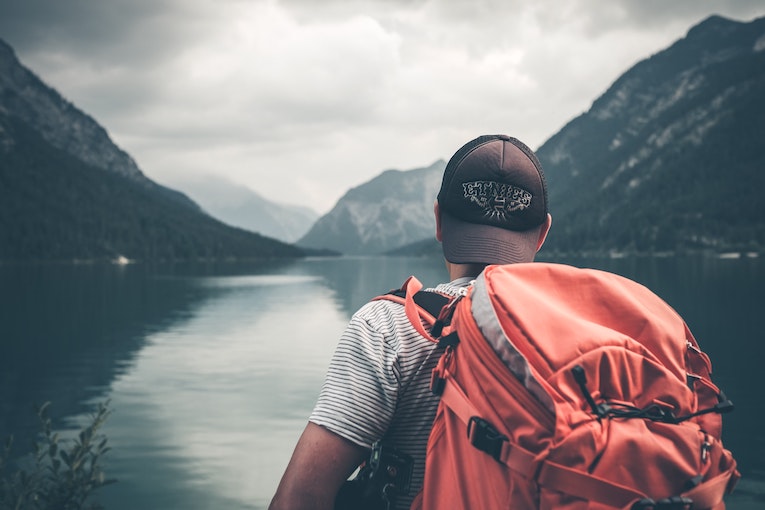
First step to adventure? Preparing for an international flight.
But international travel isn’t all fun and games. Between visas, security checks, long haul flights, and the drama of packing, international travel can be overwhelming—whether it’s your first time flying internationally or not.
It’s natural to have questions as you’re preparing for an international flight. Learn what to know before flying internationally, so you can begin your travel plans with confidence and ease.
If it is your first time flying internationally alone, you may be wondering, “ where do I even start? ” Who can help you navigate the nitty gritty of international travel? Lucky for you, every question you could imagine is right here at your fingertips.
What is the difference between domestic and international flights?
While domestic flights take you to other destinations within the same country, international flights take you overseas. If you’re planning to travel abroad, it’s important to know that you’ll be flying internationally.
Airports typically have separate domestic and international departures, with airport procedures before take off looking quite different. Keep reading to find out what to know when flying internationally.
How early do you need to be at the airport for international flights?
When preparing for an international flight, you’ll need to arrive at the airport at least three hours before your departure time. Three hours might seem like a long time, but between checking your bags, moving through various security checkpoints that may have you waiting in enormous lines, and finding your way to your gate, you’ll be happy you allowed yourself plenty of time.
Most international flights begin boarding between 40 and 60 minutes before take-off, leaving you only about two of those hours to get to your plane. Worst-case scenario? You arrive early and get to kill time in the food court or grab a quick beverage at the airport bar.

Dig into a pre-flight meal while you wait for your flight to board.
What do I need to fly internationally?
Flying internationally requires a lot more than just your passport. While your passport is absolutely essential , most countries require your passport to be valid for at least six months longer than the dates of your trip. Some places also require you to have a certain number of blank pages to allow for visas and stamps.
Depending on where you’re headed, you may also need a visa , proof of onward or return travel, or proof of immunizations. The truth is, every destination will have different travel regulations, so it’s important to check with your destination when preparing for an international flight.
FAQs about preparing for an international flight
1. how to pack for international flight.
Packing for an international flight can be overwhelming, no matter how long you plan to be away. The very first step is to check your baggage allowance with the airline. How many bags are you allowed to bring on board? How big can they be and how much can they weigh?
Once you figure out how much you can bring, separate your checked and carry on bags:
- In your checked luggage, pack classic clothing items that can be mixed and matched to save space—even better if they’re lightweight and quick-drying fabrics. Remember that less is more, especially because you’ll want to leave a little extra room for souvenirs.
- In your carry on, pack your essentials, all your travel documents, and anything you might need while in flight.
Don't forget to weigh your bags after packing to make sure you aren’t hit with outrageous luggage fees at the airport.
2. How to prepare for a long international flight
When preparing for an international flight, you can do a few things to make sure you’re ready for the long haul:
- Get lots of rest in the lead up to your trip—flying can be exhausting!
- Take your Vitamin C to boost your immune system.
- Move your body before the flight so you feel prepared to sit for longer periods of time.
- Load up on entertainment—music, movies, TV shows, and books—to keep you busy in flight.
- Set your phone to the local time zone of your destination as soon as you get on your flight so you can minimize jet lag.
Remember, the more prepared you are, the less anxious you’ll feel when it comes time to travel.
3. What to do before an international flight

If it’s your first time flying internationally, making a to-do list will help ease your mind.
Make yourself a checklist. Do you have your passport, visa, and all your travel documents easily accessible? Have you purchased travel insurance ? It’s always a good idea to have travel insurance to protect yourself during international travel, just in case.
Next, make sure you let your bank know you’ll be traveling overseas. Having your bank freeze your credit card for unexpected transactions while you’re abroad is one big (but avoidable) travel nightmare .
So, notify your bank that you’ll be traveling. While you’re at it, check the international transaction fee policy so you know what to expect, and perhaps get some cash converted so you have it on hand when you land. ATM fees are usually most expensive at the airport, so it’s always comforting to have cash on arrival.
Last but not least, check the health advisories and travel warnings for your destination so you can ensure you’re safe when preparing for an international flight.
4. What to bring to the airport when traveling internationally
If it’s your first time flying internationally alone , there’s no such thing as preparing too much. Make sure you bring all of your travel documents with you, and if you have time, make digital copies of your travel documents too. You’ll want to bring all of these to the airport with you along with your carry on and checked luggage—and your comfiest clothes to wear in flight.
FAQs about documents needed for an international flight
1. what are the documents required for international travel.
When flying internationally, having a valid passport is non-negotiable. However, every country has different travel requirements beyond that.
If your destination country requires a visa, you will need to show this at the airport when you check in for your flight. In the days of COVID-19 , you may also need to show proof of vaccination for travel.
Check out the policies of your departure, arrival, and any transiting countries so you know exactly what documents are required for each leg of your trip.
2. Can you travel internationally with just a passport?
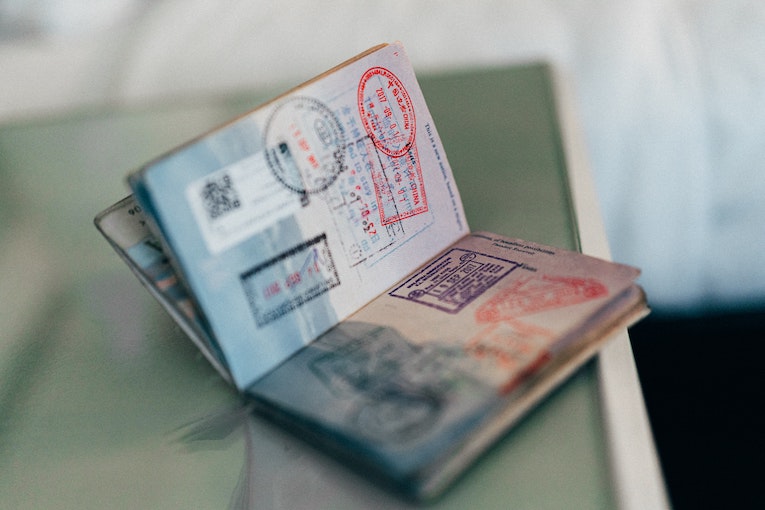
Ready to start collecting passport stamps? Yeah, we thought so.
This depends on where you’re traveling. Some countries allow departure and entry with just a passport, but many international destinations require a visa in some capacity.
Some countries allow you to get a visa on entry, with some visas free and others obtained with a fee. This is another big one to check on your destination’s immigration website before you depart so you know exactly what to expect when flying internationally.
3. Do I need my driver's license to travel internationally?
Typically, you’ll only need to show your passport when checking in for a flight, but it’s always a good idea to bring a driver’s license or another form of ID just in case.
Your driver’s license may come in handy more when you arrive at your destination, as carrying your passport around in a foreign country comes with some risks. You might want to put your passport away, lock it in your hotel safe, and use another form of identification when you’re out and about abroad.
4. Do you need two forms of ID to fly internationally?
Though you typically will not need two forms of ID to board a flight, if you have a second form of ID, bring it with you. If you are requested to show a backup ID or lose your passport while abroad, it’s always a good idea to have multiple proofs of identification on hand.
FAQs about international connections and baggage
1. what is allowed in carry on luggage on international flights.
Most airlines have a limit to how much luggage you can carry onto a plane as well as limits on the size, shape, and weight of your bags. Many airlines allow one piece of carry on luggage plus a personal item like a purse or backpack that can fit under your seat, but it’s always best to check with your airline.
You’ll always need to limit the amount of liquids you carry on to small bottles of 100 mL or less. All bottles will need to fit into one quart-size resealable bag.
Other regulated items include:
- Sharp objects
- Household items and tools
- Medical equipment
When packing your carry on, check the TSA guidelines .
2. What to pack in a carry on for an international flight

Your favorite clothes are just the top of your must-have packing list.
Use this checklist for packing your carry on to feel prepared for your international adventure:
- All travel documents (passport, visa, etc.) plus copies of each.
- Small toiletries that you’ll need for a long haul—think toothbrush, toothpaste, and deodorant at least.
- Any medications needed abroad, stored in their original containers.
- An eye mask, ear plugs, and pillow to get a good night’s sleep.
- An empty water bottle that’s easy to refill.
- Your electronics (laptop, phone, kindle, headphones) and their chargers.
- Snacks to tide you over, especially if you won’t have meals served on your flight.
- Spare undies and a change of clothes—just in case!
- A pen for your customs forms.
- Any other valuables.
3. Do I have to recheck my luggage on an international flight?
If you’re wondering what to know before flying internationally with layovers, it’s always best to check with your specific airline. Most international flights will check your luggage all the way through to your final destination, but this could change depending on your flight route.
For example, some countries require you to recheck your bag at the first point of entry, which means you’d need to pick up your bag, go through customs, and then recheck your suitcase for your next flight. When you first check your luggage at the departure terminal, ask the airline staff and they will let you know if your particular flight path requires you to recheck your luggage.
4. How much time do you need between connecting flights internationally?
If you want to be safe, allow at least two hours between connecting flights. Sometimes you can get away with shorter layovers, but it will undoubtedly be stressful.
Remember you may need to go through security if your connection is in another country, and it’s common for flights to be delayed—two hours will go by in a flash.
5. When do you go through customs on international flights?
Usually, you go through customs when you exit the airport at your final destination. However, if you have a layover in a different city in your destination country, you may need to go through customs before your connecting flight.
How to board international flight step by step

You’ve got this! Memories to last a lifetime wait on the other side of your flight.
Now that you know what to expect when flying internationally, it’s just a matter of showing up at the airport and going through the process to check in and get to your gate. Don’t be intimidated, it’s actually quite simple!
1. Check in for your flight.
Sometimes you can check in online, but if you have enough time and have questions, checking in at the airport can ease your nerves. This way, you can speak to your airline staff and ask any questions about your journey that you haven’t answered already. Make your way to the international terminal and find your airline’s check-in stand to get started.
2. Check your baggage and get your ticket.
When checking in for your flight, you’ll have an opportunity to check your luggage. The airline staff will give you your boarding pass and a tracking sticker that matches the one on your luggage. Keep these safe and tucked into your passport for easy access throughout the airport.
3. Go through the security checkpoint.
Now that you’ve lightened your load, it’s time to go through security. Follow the airport signs or ask the airline staff where to get in line for the security checkpoint. Typically, this involves waiting in line, scanning your carry on luggage, and showing your passport and boarding pass to enter the terminal.
4. Go through immigration.
If you’re flying internationally, you may need to go through a second security screening before your flight: immigration. All you’ll need to do here is show your passport and follow the instructions from the immigration staff. This is the last step before you can walk to your gate for your flight.
5. Find your gate.
You’re in! Your boarding pass will usually tell you the gate where you’ll board, but if it doesn’t, check the screens just past immigration. These screens list all destinations and their boarding gates. You may also want to double-check the information on your boarding pass—gates sometimes change.
Make your way to your gate and relax. If you arrive with time to spare, you may wish to explore your terminal a bit more, shop for snacks or books, or grab a meal and drink at one of the bars or restaurants nearby.
6. Board your flight.
About 40 to 60 minutes before your international flight, you will hear the airline staff announce boarding. Make sure you are at your gate and ready to board. Many airlines will board in groups, so check your boarding pass for your boarding group or zone, wait to be called, and line up. Have your passport and boarding pass ready to show the flight attendant, find your seat, and enjoy the ride!
Our Online Advisor can match you with 5 travel programs—it’s free!
Don’t panic—flying internationally is so much easier than it seems.

The world awaits, so where will your first international flight take you?
While there’s a lot more to flying internationally than traveling on a domestic flight, it’s actually so much easier than it seems. Give yourself plenty of time to prepare for that first time flying internationally to make sure you have everything you need, and don’t be afraid to ask questions if you’re in doubt. Once you know what to expect when flying internationally, those long flights will seem like a breeze and the world will be at your fingertips .
Find Flights & Transportation with Our Travel Resource Hub

Want to Get Matched with Programs?

Use MyGoAbroad to Save & Compare Programs!
Related articles, global respectful disruption summit: why it’s worth it & what to expect, how to practice cultural sensitivity during meaningful travel, how to make travel meaningful in 2024, announcing goabroad’s top rated providers of 2023, what solo travel teaches you, 11 undeniable benefits of solo travel, popular searches, study abroad programs in italy, study abroad programs in spain, marine biology study abroad programs, study environmental studies abroad, fall study abroad 2024, spring study abroad programs, recommended programs.

2565 reviews
International TEFL Academy

1675 reviews
International Volunteer HQ [IVHQ]

1894 reviews
MAXIMO NIVEL

555 reviews
Intern Abroad HQ
For Travelers
Travel resources, for partners.

© Copyright 1998 - 2024 GoAbroad.com ®
- Study Abroad
- Volunteer Abroad
- Intern Abroad
- Teach Abroad
- TEFL Courses
- Degrees Abroad
- High School Abroad
- Language Schools
- Adventure Travel
- Jobs Abroad
- Online Study Abroad
- Online Volunteer Programs
- Online Internships
- Online Language Courses
- Online Teaching Jobs
- Online Jobs
- Online TEFL Courses
- Online Degree Programs

Looking For International Travel Inspiration?
Learn what the world has to offer from our writers who have experienced it.

Most Popular Travel Blogs
What to do in nusa penida, bali, yakitori alley – the culinary hidden gem of tokyo, what to do in seychelles islands, will i be lonely as a solo traveler, what to do in kuta beach, bali, what to do in seminyak, bali, why are flights so expensive, what to do in uluwatu, bali, what to do in ubud, bali, best hiking sunglasses, best south haven restaurants, top 10 things to do in bali, where is bali, what to do in canggu, bali, top sights to see in katherine, nt northern territory, reasons to visit mongolia, most popular locations.
- Philippines
Middle East & North Africa
- Sharm El-Sheikh
North America
- Grand Canyon National Park
- Los Angeles
- Mayan Riviera
- New York City
- Niagara Falls
- San Francisco
South America
- Iguazu Falls
Central America
- El Salvador
Eastern Europe
Southern europe, western europe, australia / new zealand.
- New Zealand North Island
- New Zealand South Island
Most Recent Travel Blogs
Venice weather in december, thailand weather in june, smallest countries in europe, thailand weather in october, thailand weather in september, vienna weather in may, bruny island travel guide, lamington national park travel guide, top places in the world to visit, thailand weather in november, top 10 things to do in thailand, gold coast travel guide, burnie travel guide, “i haven’t been everywhere, but it’s on my list .” -susan sontag, search by country.
- South Korea
- United Kingdom
- Switzerland
- Saudi Arabia
Australia & South Pacific
- New Zealand
- South Africa

All Articles
© 2024 Go International Travel | Your Go To International Travel Guide.
- KAYAK for Business NEW
International Travel Restrictions by Country
Find out where you can travel and covid-19 policies.
Select origin country, search destination or select a country on the map to see travel restrictions.
The travel status of individual countries can change suddenly, and we know it can be hard to stay on top of it all. That's why we're getting you the information you need to consider when planning travel. Learn about country-specific entry requirements such as the border status, COVID-19 testing requirements, and quarantine requirements. Many countries are reopening their borders for international travel. Find out which countries are open to vaccinated travelers.
Just enter your departure country above - the map will update to reflect countries' opening status and any entry requirements for air travelers. Before you book, be sure to double check your country's official government site.
Destinations you can travel to now
Dominican republic, netherlands, philippines, puerto rico, switzerland, united arab emirates, united kingdom, know when to go.
Sign up for email alerts as countries begin to open - choose the destinations you're interested in so you're in the know.
Filter by region, status and more
Most visitors from the United States, regardless of vaccination status, can enter Albania.
Most visitors from the United States, regardless of vaccination status, can enter Algeria.
American Samoa
Most visitors from the United States, regardless of vaccination status, can enter American Samoa.
Most visitors from the United States, regardless of vaccination status, can enter Angola.
Most visitors from the United States, regardless of vaccination status, can enter Anguilla.
Antigua And Barbuda
Most visitors from the United States, regardless of vaccination status, can enter Antigua And Barbuda.
Most visitors from the United States, regardless of vaccination status, can enter Argentina.
Most visitors from the United States, regardless of vaccination status, can enter Armenia.
Most visitors from the United States, regardless of vaccination status, can enter Aruba.
Most visitors from the United States, regardless of vaccination status, can enter Australia.
Most visitors from the United States, regardless of vaccination status, can enter Austria.
Most visitors from the United States, regardless of vaccination status, can enter Azerbaijan.
Most visitors from the United States, regardless of vaccination status, can enter Bahrain.
Most visitors from the United States, regardless of vaccination status, can enter Bangladesh.
Most visitors from the United States, regardless of vaccination status, can enter Barbados.
Most visitors from the United States, regardless of vaccination status, can enter Belgium.
Most visitors from the United States, regardless of vaccination status, can enter Belize.
Most visitors from the United States, regardless of vaccination status, can enter Benin.
Most visitors from the United States, regardless of vaccination status, can enter Bermuda.
Most visitors from the United States, regardless of vaccination status, can enter Bhutan.
Most visitors from the United States, regardless of vaccination status, can enter Bolivia.
Bosnia and Herzegovina
Most visitors from the United States, regardless of vaccination status, can enter Bosnia and Herzegovina.
Most visitors from the United States, regardless of vaccination status, can enter Botswana.
Most visitors from the United States, regardless of vaccination status, can enter Brazil.
British Virgin Islands
Most visitors from the United States, regardless of vaccination status, can enter the British Virgin Islands.
Brunei Darussalam
Most visitors from the United States, regardless of vaccination status, can enter Brunei Darussalam.
Most visitors from the United States, regardless of vaccination status, can enter Bulgaria.
Most visitors from the United States, regardless of vaccination status, can enter Burundi.
Most visitors from the United States, regardless of vaccination status, can enter Cambodia.
Most visitors from the United States, regardless of vaccination status, can enter Cameroon.
Most visitors from the United States, regardless of vaccination status, can enter Canada.
Most visitors from the United States, regardless of vaccination status, can enter Cape Verde.
Caribbean Netherlands
Most visitors from the United States, regardless of vaccination status, can enter the Caribbean Netherlands.
Cayman Islands
Most visitors from the United States, regardless of vaccination status, can enter the Cayman Islands.
Most visitors from the United States, regardless of vaccination status, can enter Chad.
Most visitors from the United States, regardless of vaccination status, can enter Chile.
Most visitors from the United States, regardless of vaccination status, can enter China.
Most visitors from the United States, regardless of vaccination status, can enter Colombia.
Most visitors from the United States, regardless of vaccination status, can enter the Comoros.
Cook Islands
Most visitors from the United States, regardless of vaccination status, can enter the Cook Islands.
Most visitors from the United States, regardless of vaccination status, can enter Costa Rica.
Most visitors from the United States, regardless of vaccination status, can enter Croatia.
Most visitors from the United States, regardless of vaccination status, can enter Curaçao.
Most visitors from the United States, regardless of vaccination status, can enter Cyprus.
Czech Republic
Most visitors from the United States, regardless of vaccination status, can enter the Czech Republic.
Democratic Republic of the Congo
Most visitors from the United States, regardless of vaccination status, can enter the Democratic Republic of the Congo.
Most visitors from the United States, regardless of vaccination status, can enter Denmark.
Fully vaccinated visitors from the United States can enter Djibouti without restrictions.
Most visitors from the United States, regardless of vaccination status, can enter Dominica.
Most visitors from the United States, regardless of vaccination status, can enter the Dominican Republic.
Most visitors from the United States, regardless of vaccination status, need to quarantine to enter East Timor.
Most visitors from the United States, regardless of vaccination status, can enter Ecuador.
Most visitors from the United States, regardless of vaccination status, can enter Egypt.
El Salvador
Most visitors from the United States, regardless of vaccination status, can enter El Salvador.
Equatorial Guinea
Most visitors from the United States, regardless of vaccination status, can enter Equatorial Guinea.
Most visitors from the United States, regardless of vaccination status, can enter Eritrea.
Most visitors from the United States, regardless of vaccination status, can enter Estonia.
Most visitors from the United States, regardless of vaccination status, can enter Eswatini.
Most visitors from the United States, regardless of vaccination status, can enter Ethiopia.
Falkland Islands (Islas Malvinas)
Most visitors from the United States, regardless of vaccination status, can enter Falkland Islands (Islas Malvinas).
Faroe Islands
Most visitors from the United States, regardless of vaccination status, can enter the Faroe Islands.
Federated States of Micronesia
Most visitors from the United States, regardless of vaccination status, can enter Federated States of Micronesia.
Most visitors from the United States, regardless of vaccination status, can enter Fiji.
Most visitors from the United States, regardless of vaccination status, can enter Finland.
Most visitors from the United States, regardless of vaccination status, can enter France.
French Guiana
Most visitors from the United States, regardless of vaccination status, can enter French Guiana.
French Polynesia
Most visitors from the United States, regardless of vaccination status, can enter French Polynesia.
Most visitors from the United States, regardless of vaccination status, can enter Gabon.
Most visitors from the United States, regardless of vaccination status, can enter the Gambia.
Most visitors from the United States, regardless of vaccination status, can enter Georgia.
Most visitors from the United States, regardless of vaccination status, can enter Germany.
Most visitors from the United States, regardless of vaccination status, can enter Ghana.
Most visitors from the United States, regardless of vaccination status, can enter Gibraltar.
Most visitors from the United States, regardless of vaccination status, can enter Greece.
Most visitors from the United States, regardless of vaccination status, can enter Greenland.
Most visitors from the United States, regardless of vaccination status, can enter Grenada.
Most visitors from the United States, regardless of vaccination status, can enter Guadeloupe.
Most visitors from the United States, regardless of vaccination status, can enter Guam.
Most visitors from the United States, regardless of vaccination status, can enter Guatemala.
Most visitors from the United States, regardless of vaccination status, can enter Guinea.
Guinea-Bissau
Most visitors from the United States, regardless of vaccination status, can enter Guinea-Bissau.
Most visitors from the United States, regardless of vaccination status, can enter Guyana.
Most visitors from the United States, regardless of vaccination status, can enter Honduras.
Most visitors from the United States, regardless of vaccination status, can enter Hong Kong.
Most visitors from the United States, regardless of vaccination status, can enter Hungary.
Most visitors from the United States, regardless of vaccination status, can enter Iceland.
Most visitors from the United States, regardless of vaccination status, can enter India.
Most visitors from the United States, regardless of vaccination status, can enter Indonesia.
Most visitors from the United States, regardless of vaccination status, can enter Ireland.
Most visitors from the United States, regardless of vaccination status, can enter Italy.
Ivory Coast
Most visitors from the United States, regardless of vaccination status, can enter Ivory Coast.
Most visitors from the United States, regardless of vaccination status, can enter Jamaica.
Most visitors from the United States, regardless of vaccination status, can enter Japan.
Most visitors from the United States, regardless of vaccination status, can enter Jersey.
Most visitors from the United States, regardless of vaccination status, can enter Jordan.
Most visitors from the United States, regardless of vaccination status, can enter Kazakhstan.
Most visitors from the United States, regardless of vaccination status, can enter Kenya.
Most visitors from the United States, regardless of vaccination status, can enter Kiribati.
Most visitors from the United States, regardless of vaccination status, can enter Kosovo.
Most visitors from the United States, regardless of vaccination status, can enter Kuwait.
Most visitors from the United States, regardless of vaccination status, can enter Kyrgyzstan.
Most visitors from the United States, regardless of vaccination status, can enter Laos.
Most visitors from the United States, regardless of vaccination status, can enter Latvia.
Most visitors from the United States, regardless of vaccination status, can enter Lesotho.
Most visitors from the United States, regardless of vaccination status, can enter Liberia.
Liechtenstein
Most visitors from the United States, regardless of vaccination status, can enter Liechtenstein.
Most visitors from the United States, regardless of vaccination status, can enter Lithuania.
Most visitors from the United States, regardless of vaccination status, can enter Luxembourg.
Most visitors from the United States, regardless of vaccination status, can enter Macau.
Most visitors from the United States, regardless of vaccination status, can enter Madagascar.
Most visitors from the United States, regardless of vaccination status, can enter Malawi.
Most visitors from the United States, regardless of vaccination status, can enter Malaysia.
Most visitors from the United States, regardless of vaccination status, can enter the Maldives.
Most visitors from the United States, regardless of vaccination status, can enter Malta.
Marshall Islands
Most visitors from the United States, regardless of vaccination status, can enter the Marshall Islands.
Most visitors from the United States, regardless of vaccination status, can enter Martinique.
Most visitors from the United States, regardless of vaccination status, can enter Mauritania.
Most visitors from the United States, regardless of vaccination status, can enter Mauritius.
Most visitors from the United States, regardless of vaccination status, can enter Mayotte.
Most visitors from the United States, regardless of vaccination status, can enter Mexico.
Most visitors from the United States, regardless of vaccination status, can enter Moldova.
Most visitors from the United States, regardless of vaccination status, can enter Mongolia.
Most visitors from the United States, regardless of vaccination status, can enter Montenegro.
Most visitors from the United States, regardless of vaccination status, can enter Montserrat.
Most visitors from the United States, regardless of vaccination status, can enter Mozambique.
Most visitors from the United States, regardless of vaccination status, can enter Namibia.
Fully vaccinated visitors from the United States can enter Nauru without restrictions.
Most visitors from the United States, regardless of vaccination status, can enter Nepal.
Most visitors from the United States, regardless of vaccination status, can enter the Netherlands.
New Caledonia
Most visitors from the United States, regardless of vaccination status, can enter New Caledonia.
New Zealand
Most visitors from the United States, regardless of vaccination status, can enter New Zealand.
Most visitors from the United States, regardless of vaccination status, can enter Nicaragua.
Fully vaccinated visitors from the United States can enter Niger without restrictions.
Most visitors from the United States, regardless of vaccination status, can enter Nigeria.
North Macedonia
Most visitors from the United States, regardless of vaccination status, can enter North Macedonia.
Northern Mariana Islands
Most visitors from the United States, regardless of vaccination status, can enter the Northern Mariana Islands.
Most visitors from the United States, regardless of vaccination status, can enter Norway.
Most visitors from the United States, regardless of vaccination status, can enter Oman.
Most visitors from the United States, regardless of vaccination status, can enter Pakistan.
Most visitors from the United States, regardless of vaccination status, can enter Palau.
Most visitors from the United States, regardless of vaccination status, can enter Panama.
Papua New Guinea
Most visitors from the United States, regardless of vaccination status, can enter Papua New Guinea.
Most visitors from the United States, regardless of vaccination status, can enter Paraguay.
Most visitors from the United States, regardless of vaccination status, can enter Peru.
Most visitors from the United States, regardless of vaccination status, can enter the Philippines.
Most visitors from the United States, regardless of vaccination status, can enter Poland.
Most visitors from the United States, regardless of vaccination status, can enter Portugal.
Most visitors from the United States, regardless of vaccination status, can enter Puerto Rico.
Most visitors from the United States, regardless of vaccination status, can enter Qatar.
Republic of the Congo
Fully vaccinated visitors from the United States can enter Republic of the Congo without restrictions.
Most visitors from the United States, regardless of vaccination status, can enter Réunion.
Most visitors from the United States, regardless of vaccination status, can enter Romania.
Most visitors from the United States, regardless of vaccination status, can enter Rwanda.
Saint Barthélemy
Most visitors from the United States, regardless of vaccination status, can enter Saint Barthélemy.
Saint Kitts and Nevis
Most visitors from the United States, regardless of vaccination status, can enter Saint Kitts and Nevis.
Saint Lucia
Most visitors from the United States, regardless of vaccination status, can enter Saint Lucia.
Saint Martin
Most visitors from the United States, regardless of vaccination status, can enter Saint Martin.
Saint Vincent and the Grenadines
Most visitors from the United States, regardless of vaccination status, can enter Saint Vincent and the Grenadines.
Most visitors from the United States, regardless of vaccination status, can enter Samoa.
São Tomé and Príncipe
Most visitors from the United States, regardless of vaccination status, can enter São Tomé and Príncipe.
Saudi Arabia
Most visitors from the United States, regardless of vaccination status, can enter Saudi Arabia.
Most visitors from the United States, regardless of vaccination status, can enter Senegal.
Most visitors from the United States, regardless of vaccination status, can enter Serbia.
Most visitors from the United States, regardless of vaccination status, can enter Seychelles.
Sierra Leone
Most visitors from the United States, regardless of vaccination status, can enter Sierra Leone.
Most visitors from the United States, regardless of vaccination status, can enter Singapore.
Most visitors from the United States, regardless of vaccination status, can enter Slovakia.
Most visitors from the United States, regardless of vaccination status, can enter Slovenia.
Solomon Islands
Most visitors from the United States, regardless of vaccination status, can enter the Solomon Islands.
South Africa
Most visitors from the United States, regardless of vaccination status, can enter South Africa.
South Korea
Most visitors from the United States, regardless of vaccination status, can enter South Korea.
Most visitors from the United States, regardless of vaccination status, can enter Spain.
Most visitors from the United States, regardless of vaccination status, can enter Sri Lanka.
St. Maarten
Most visitors from the United States, regardless of vaccination status, can enter St. Maarten.
Most visitors from the United States, regardless of vaccination status, can enter Sudan.
Most visitors from the United States, regardless of vaccination status, can enter Suriname.
Most visitors from the United States, regardless of vaccination status, can enter Sweden.
Most visitors from the United States, regardless of vaccination status, can enter Switzerland.
Most visitors from the United States, regardless of vaccination status, can enter Taiwan.
Most visitors from the United States, regardless of vaccination status, can enter Tajikistan.
Most visitors from the United States, regardless of vaccination status, can enter Tanzania.
Most visitors from the United States, regardless of vaccination status, can enter Thailand.
The Bahamas
Most visitors from the United States, regardless of vaccination status, can enter The Bahamas.
Most visitors from the United States, regardless of vaccination status, can enter Togo.
Most visitors from the United States, regardless of vaccination status, can enter Tonga.
Trinidad and Tobago
Most visitors from the United States, regardless of vaccination status, can enter Trinidad and Tobago.
Most visitors from the United States, regardless of vaccination status, can enter Tunisia.
Most visitors from the United States, regardless of vaccination status, can enter Türkiye.
Turkmenistan
Most visitors from the United States, regardless of vaccination status, will not be allowed to enter Turkmenistan.
Turks and Caicos Islands
Most visitors from the United States, regardless of vaccination status, can enter the Turks and Caicos Islands.
Most visitors from the United States, regardless of vaccination status, can enter Tuvalu.
U.S. Virgin Islands
Most visitors from the United States, regardless of vaccination status, can enter the U.S. Virgin Islands.
Most visitors from the United States, regardless of vaccination status, can enter Uganda.
Most visitors from the United States, regardless of vaccination status, can enter the United Arab Emirates.
Most visitors from the United States, regardless of vaccination status, can enter the United Kingdom.
Most visitors from the United States, regardless of vaccination status, can enter Uruguay.
Most visitors from the United States, regardless of vaccination status, can enter Uzbekistan.
Most visitors from the United States, regardless of vaccination status, can enter Vanuatu.
Most visitors from the United States, regardless of vaccination status, can enter Vietnam.
Wallis and Futuna
Most visitors from the United States, regardless of vaccination status, can enter Wallis and Futuna.
Western Sahara
Most visitors from the United States, regardless of vaccination status, will not be allowed to enter Western Sahara.
Most visitors from the United States, regardless of vaccination status, can enter Zambia.
Most visitors from the United States, regardless of vaccination status, can enter Zimbabwe.
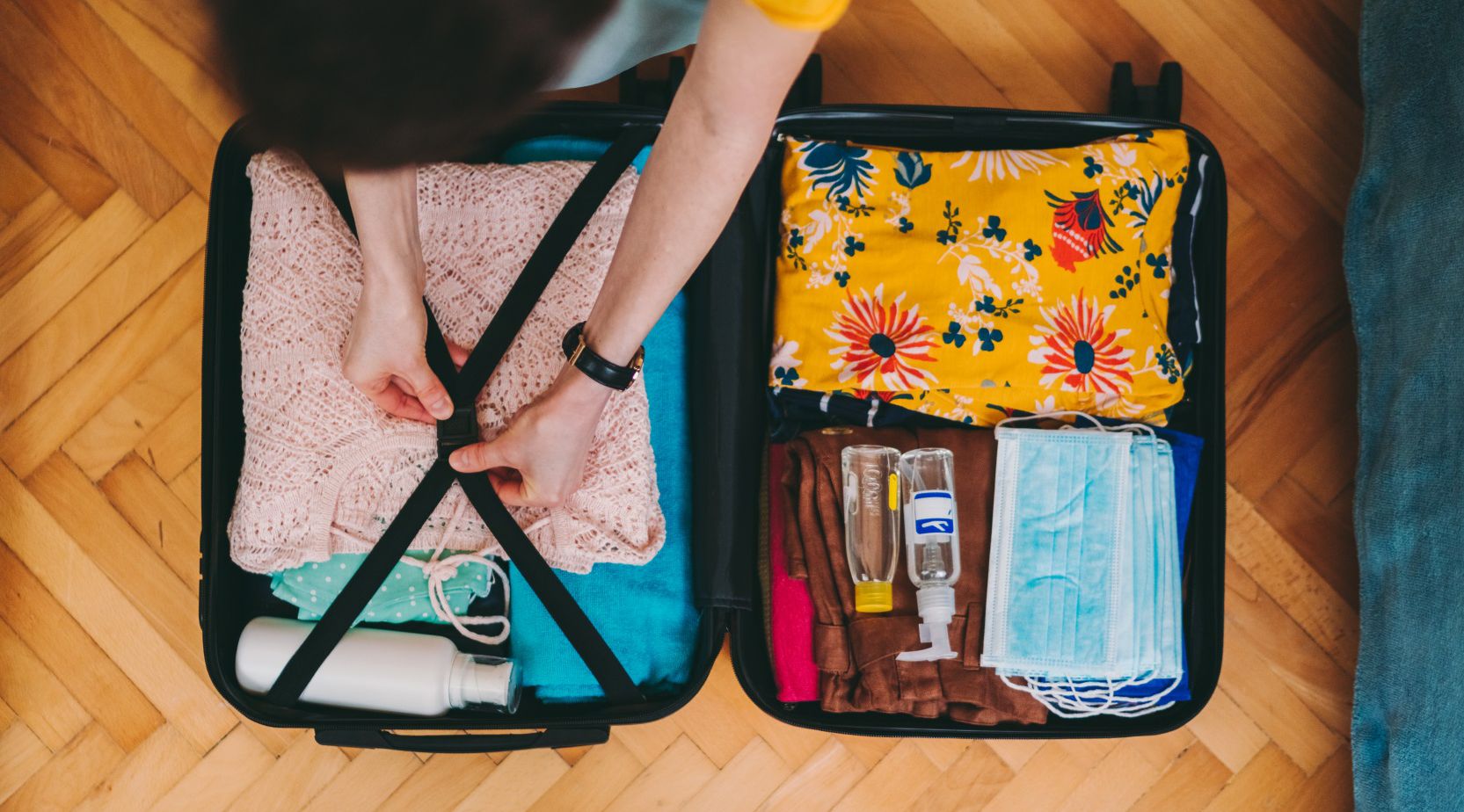
Get trip-ready with at-home COVID-19 tests
How often is the data on this page updated.
We check for travel restriction information from government authorities daily, and update the page any time we get new information. The following information regarding travel restrictions for each country is correct to the best of our knowledge at the time of publication.
How many countries are closed to visitors?
As of Sep 11, 2 countries have completely restricted entry to non-citizens and 5 are open but require quarantine and/or a negative COVID test.
Where can I travel without COVID restrictions?
Currently you can travel from the United States to 197 countries without restrictions. Please check our map to learn more.
Are there any other types of travel restrictions besides COVID-19 tests and quarantines?
These are the two main types of restrictions or requirements needed to travel into another country. However, the COVID-19 testing options are continually widening as new methods are developed. Different countries may accept results from different or multiple test types, so be sure to check the individual country's specific requirements.
What should I do if I get COVID-19 while in another country?
If you get COVID-19 while in another country, follow the local authority's recommendations. These may include hospitalization, self-isolating and testing in that country. Be sure to contact your travel insurance company and travel provider as well and inform them of your situation.
What should I do if the borders of the country I am visiting close?
Depending on your home country, you may need to change your departure date and return home as soon as possible. If that's the case, contact your travel provider to find the earliest departure.
Additional resources
- What you need to know
- Airline policies
- Hotel policies
- Car policies
- Tips for flying
- Tips for hotel
- Tips for vacation rental
If you're looking for personalized travel advice for your own travel plans like whether or not a restriction applies to your trip, we won't be able to answer any questions or offer advice. Please consult your local government's resources.
Advertisement
Supported by
The Documents You Need to Travel Abroad Now
The pandemic has created a whole new checklist of what you should bring on your trip. Here’s the essential paperwork you need to have in your bag.
- Share full article

By Lauren Sloss
While international travel is not impossible this holiday season, particularly if you’re vaccinated, the rise of the Omicron variant promises to make it much more complicated .
Assuming you are traveling to a country open to nonessential travel, the vaccine and testing documentation required for entry could range from nothing (Mexico) to detailed and numerous (Norway, and many others). Before booking, you can research online what you’ll need — on a running list from The New York Times here , or the websites of various airlines, the C.D.C ., the U.S. State Department or that of your destination’s government — but be prepared to recheck requirements in the days leading up to your departure, in case rules have changed.
Here are the types of documentation that many destinations now require from U.S. travelers. As in prepandemic times, make physical copies of everything and if you have digital versions, organize them in an accessible place on your phone. Keep them handy, too, as you will be asked for your documents multiple times during your journey.
Proof of vaccination
No matter your destination, no matter what requirements it has for proving you are vaccinated against the coronavirus, it’s smart to bring your physical, C.D.C.-issued vaccine card with you, along with digital photos of your card and paper photocopies. You might not need it — be sure to store it safely — but don’t assume that a U.S.-based digital passport or QR code is acceptable. For example, your physical C.D.C. card will be accepted in France and the United Kingdom; the latter, however, also accepts certain state-issued digital health apps for entry , like California’s Vaccine Record and New York’s Excelsior Pass . And remember to check what vaccines are accepted at your destination.
A completed locator form
Some destinations, including the United Kingdom and certain European Union countries , require travelers to complete a digital passenger locator form before entering the country (you must submit the U.K. form in the 48 hours before you arrive in the country), to help with contact tracing. In addition to your travel information, vaccination status and contact information, the form may ask for your address in the country, and, in the U.K, confirmation of scheduled coronavirus tests that you need to take after arrival. With its locator form, Croatia asks for proof of paid accommodation, and if you’re traveling to Canada, you will need to download and submit information using the ArriveCan mobile app within 72 hours before your arrival.
Coronavirus test results
More countries now require proof of a negative test, often in addition to proof of vaccination. Depending on where you are going, some countries require P.C.R. tests, while others allow rapid antigen tests. The timing requirement of your test might ask for results between 24 or 72 hours before your arrival, or one to three days. Take Croatia again: The country requires a negative P.C.R. test taken within 72 hours or a rapid antigen test within 48; if you have neither, you’ll be required to test upon arrival at your own cost and quarantine until you receive negative results. Rules for unvaccinated children vary widely by country and age, too — when entering Denmark , fully vaccinated adults or children under 16 do not need proof of a negative test, while 16- and 17-year-olds must have proof of a negative test to enter. Again, have the results in both digital and physical form.
Mask mandates too vary by country and maybe localities, but you will most certainly need masks in airports, on your flight — and if you are going to most places in Europe and the U.K. , for indoor activities like dining. And rather than hoping your cloth mask will have you covered, come prepared with surgical masks and N95s as well. For example, you need N95s,KN95s or FFP2 to ride public transport in Germany .
Proof of insurance
Not only is it a good idea to check your health-insurance policies if you get sick abroad, you should research whether proof of health or travel insurance is needed at your destination. While Egypt , Jordan and many Caribbean nations require proof of health insurance, travelers to Chile , in addition to proof of vaccination and a negative test, must also show “proof of travel medical insurance that covers at least $30,000.” For unvaccinated travelers, Costa Rica requires insurance that covers any Covid-related costs, including but not exclusive to illness.
With minors, proof of relationship
If you are traveling with children, particularly as a single parent or if your child will be traveling with other relatives, Erika Richter, director of communications of the American Society of Travel Advisors, strongly recommends having a child consent form and a proof of relationship, like a birth certificate or court document, in addition to the child’s passport.
Speaking of passports …
Confirm that your passport and any required visas are valid. “Your passport should have an expiration date of at least six months from your return date,” said Alexis Bowen, a co-founder of the travel company elsewhere .
Test for your return trip
All travelers, vaccinated or not, wishing to fly into the United States from abroad are currently required to show proof of a negative coronavirus test — specifically, a rapid antigen or P.C.R. test — taken within one day of their flight. Check whether your final stop before flying has testing centers or pharmacies with approved tests, or consider consulting local connections or the hotel concierge. You can also bring F.D.A.-approved at-home tests with you. Those tests need to be supervised, meaning you’ll need Wi-Fi and an online doctor’s appointment. Finally, prepare to sign a C.D.C.-required attestation either in advance or at the airport before returning.
Follow New York Times Travel on Instagram , Twitter and Facebook . And sign up for our weekly Travel Dispatch newsletter to receive expert tips on traveling smarter and inspiration for your next vacation. Dreaming up a future getaway or just armchair traveling? Check out our 52 Places list for 2021 .
An earlier version of this article omitted a kind of mask that is acceptable to use on public transport in Germany. FFP2 masks are also acceptable, not just N95 and KN95 masks.
How we handle corrections

An official website of the United States government
Here’s how you know
Official websites use .gov A .gov website belongs to an official government organization in the United States.
Secure .gov websites use HTTPS A lock ( Lock A locked padlock ) or https:// means you’ve safely connected to the .gov website. Share sensitive information only on official, secure websites.
- Fact Sheets
Frequently Asked Questions: Guidance for Travelers to Enter the U.S.
Updated Date: April 21, 2022
Since January 22, 2022, DHS has required non-U.S. individuals seeking to enter the United States via land ports of entry and ferry terminals at the U.S.-Mexico and U.S.-Canada borders to be fully vaccinated for COVID-19 and provide proof of vaccination upon request. On April 21, 2022, DHS announced that it would extend these requirements. In determining whether and when to rescind this order, DHS anticipates that it will take account of whether the vaccination requirement for non-U.S. air travelers remains in place.
These requirements apply to non-U.S. individuals who are traveling for essential or non-essential reasons. They do not apply to U.S. citizens, Lawful Permanent Residents, or U.S. nationals.
Effective November 8, 2021, new air travel requirements applied to many noncitizens who are visiting the United States temporarily. These travelers are also required to show proof of COVID-19 vaccination. All air travelers, including U.S. persons, must test negative for COVID-19 prior to departure. Limited exceptions apply. See CDC guidance for more details regarding air travel requirements.
Below is more information about what to know before you go, and answers to Frequently Asked Questions about cross-border travel.
Entering the U.S. Through a Land Port of Entry or Ferry Terminal
Q. what are the requirements for travelers entering the united states through land poes.
A: Before embarking on a trip to the United States, non-U.S. travelers should be prepared for the following:
- Possess proof of an approved COVID-19 vaccination as outlined on the CDC website.
- During border inspection, verbally attest to their COVID-19 vaccination status.
- Bring a Western Hemisphere Travel Initiative compliant border crossing document, such as a valid passport (and visa if required), Trusted Traveler Program card, a Department of State-issued Border Crossing Card, Enhanced Driver’s License or Enhanced Tribal Card when entering the country. Travelers (including U.S. citizens) should be prepared to present the WHTI-compliant document and any other documents requested by the CBP officer.
Q. What are the requirements to enter the United States for children under the age of 18 who can't be vaccinated?
A: Children under 18 years of age are excepted from the vaccination requirement at land and ferry POEs.
Q: Which vaccines/combination of vaccines will be accepted?
A: Per CDC guidelines, all Food and Drug Administration (FDA) approved and authorized vaccines, as well as all vaccines that have an Emergency Use Listing (EUL) from the World Health Organization (WHO), will be accepted.
Accepted Vaccines:
- More details are available in CDC guidance here .
- 2 weeks (14 days) after your dose of an accepted single-dose COVID-19 vaccine;
- 2 weeks (14 days) after your second dose of an accepted 2-dose series;
- 2 weeks (14 days) after you received the full series of an accepted COVID-19 vaccine (not placebo) in a clinical trial;
- 2 weeks (14 days) after you received 2 doses of any “mix-and-match” combination of accepted COVID-19 vaccines administered at least 17 days apart.
Q. Is the United States requiring travelers to have a booster dose to be considered fully vaccinated for border entry purposes?
A: No. The CDC guidance for “full vaccination” can be found here.
Q: Do U.S. citizens or lawful permanent residents need proof of vaccination to return to the United States via land POEs and ferry terminals?
A: No. Vaccination requirements do not apply to U.S. citizens, U.S. nationals, or Lawful Permanent Residents (LPRs). Travelers that exhibit signs or symptoms of illness will be referred to CDC for additional medical evaluation.
Q: Is pre- or at-arrival COVID testing required to enter the United States via land POEs or ferry terminals?
A: No, there is no COVID testing requirement to enter the United States via land POE or ferry terminals. In this respect, the requirement for entering by a land POE or ferry terminal differs from arrival via air, where there is a requirement to have a negative test result before departure.
Processing Changes Announced on January 22, 2022
Q: new changes were recently announced. what changed on january 22.
A: Since January 22, 2022, non-citizens who are not U.S. nationals or Lawful Permanent Residents have been required to be vaccinated against COVID-19 to enter the United States at land ports of entry and ferry terminals, whether for essential or nonessential purposes. Previously, DHS required that non-U.S. persons be vaccinated against COVID-19 to enter the United States for nonessential purposes. Effective January 22, all non-U.S. individuals, to include essential travelers, must be prepared to attest to vaccination status and present proof of vaccination to a CBP officer upon request. DHS announced an extension of this policy on April 21, 2022.
Q: Who is affected by the changes announced on January 22?
A: This requirement does not apply to U.S. citizens, U.S. nationals, or U.S. Lawful Permanent Residents. It applies to other noncitizens, such as a citizen of Mexico, Canada, or any other country seeking to enter the United States through a land port of entry or ferry terminal.
Q: Do U.S. citizens need proof of vaccination to return to the United States via land port of entry or ferry terminals?
A: Vaccination requirements do not apply to U.S. Citizens, U.S. nationals or U.S. Lawful Permanent Residents. Travelers that exhibit signs or symptoms of illness will be referred to CDC for additional medical evaluation.
Q: What is essential travel?
A: Under the prior policy, there was an exception from temporary travel restrictions for “essential travel.” Essential travel included travel to attend educational institutions, travel to work in the United States, travel for emergency response and public health purposes, and travel for lawful cross-border trade (e.g., commercial truckers). Under current policy, there is no exception for essential travel.
Q: Will there be any exemptions?
A: While most non-U.S. individuals seeking to enter the United States will need to be vaccinated, there is a narrow list of exemptions consistent with the Centers for Disease Control and Prevention (CDC) Order in the air travel context.
- Certain categories of individuals on diplomatic or official foreign government travel as specified in the CDC Order
- Children under 18 years of age;
- Certain participants in certain COVID-19 vaccine trials as specified in the CDC Order;
- Individuals with medical contraindications to receiving a COVID-19 vaccine as specified in the CDC Order;
- Individuals issued a humanitarian or emergency exception by the Secretary of Homeland Security;
- Individuals with valid nonimmigrant visas (excluding B-1 [business] or B-2 [tourism] visas) who are citizens of a country with limited COVID-19 vaccine availability, as specified in the CDC Order
- Members of the U.S. Armed Forces or their spouses or children (under 18 years of age) as specified in the CDC Order; and
- Individuals whose entry would be in the U.S. national interest, as determined by the Secretary of Homeland Security.
Q: What documentation will be required to show vaccination status?
A: Non-U.S. individuals are required to be prepared to attest to vaccination status and present proof of vaccination to a CBP officer upon request regardless of the purpose of travel.
The current documentation requirement remains the same and is available on the CDC website . Documentation requirements for entry at land ports of entry and ferry terminals mirror those for entry by air.
Q: What happens if someone doesn’t have proof of vaccine status?
A: If non-U.S. individuals cannot present proof of vaccination upon request, they will not be admitted into the United States and will either be subject to removal or be allowed to withdraw their application for entry.

Q: Will incoming travelers be required to present COVID-19 test results?
A: There is no COVID-19 testing requirement for travelers at land border ports of entry, including ferry terminals.
Q: What does this mean for those who can't be vaccinated, either due to age or other health considerations?
A: See CDC guidance for additional information on this topic. Note that the vaccine requirement does not apply to children under 18 years of age.
Q: Does this requirement apply to amateur and professional athletes?
A: Yes, unless they qualify for one of the narrow CDC exemptions.
Q: Are commercial truckers required to be vaccinated?
A: Yes, unless they qualify for one of the narrow CDC exemptions. These requirements also apply to bus drivers as well as rail and ferry operators.
Q. Do you expect border wait times to increase?
A: As travelers navigate these new travel requirements, wait times may increase. Travelers should account for the possibility of longer than normal wait times and lines at U.S. land border crossings when planning their trip and are kindly encouraged to exercise patience.
To help reduce wait times and long lines, travelers can take advantage of innovative technology, such as facial biometrics and the CBP OneTM mobile application, which serves as a single portal for individuals to access CBP mobile applications and services.
Q: How is Customs and Border Protection staffing the ports of entry?
A: CBP’s current staffing levels at ports of entry throughout the United States are commensurate with pre-pandemic levels. CBP has continued to hire and train new employees throughout the pandemic. CBP expects some travelers to be non-compliant with the proof of vaccination requirements, which may at times lead to an increase in border wait times. Although trade and travel facilitation remain a priority, we cannot compromise national security, which is our primary mission. CBP Office of Field Operations will continue to dedicate its finite resources to the processing of arriving traffic with emphasis on trade facilitation to ensure economic recovery.
Q: What happens if a vaccinated individual is traveling with an unvaccinated individual?
A: The unvaccinated individual (if 18 or over) would not be eligible for admission.
Q: If I am traveling for an essential reason but am not vaccinated can I still enter?
A: No, if you are a non-U.S. individual. The policy announced on January 22, 2022 applies to both essential and non-essential travel by non-U.S. individual travelers. Since January 22, DHS has required that all inbound non-U.S. individuals crossing U.S. land or ferry POEs – whether for essential or non-essential reasons – be fully vaccinated for COVID-19 and provide related proof of vaccination upon request.
Q: Are sea crew members on vessels required to have a COVID vaccine to disembark?
A: Sea crew members traveling pursuant to a C-1 or D nonimmigrant visa are not excepted from COVID-19 vaccine requirements at the land border. This is a difference from the international air transportation context.
Entering the U.S. via Air Travel
Q: what are the covid vaccination requirements for air passengers to the united states .
A: According to CDC requirements [www.cdc.gov/coronavirus/2019-ncov/travelers/noncitizens-US-air-travel.html | Link no longer valid], most noncitizens who are visiting the United States temporarily must be fully vaccinated prior to boarding a flight to the United States. These travelers are required to show proof of vaccination. A list of covered individuals is available on the CDC website.
Q: What are the COVID testing requirements for air passengers to the United States?
A: Effective Sunday, June 12 at 12:01 a.m. ET, CDC will no longer require pre-departure COVID-19 testing for U.S.-bound air travelers.
- Border Security
- Transportation Security
- Airport Security
- Coronavirus (COVID-19)
- Customs and Border Protection (CBP)
- Transportation Security Administration (TSA)
Situation in Haiti April 5, 2024
U.s. citizens in haiti, update april 12, 2024, information for u.s. citizens in the middle east.
- Travel Advisories |
- Contact Us |
- MyTravelGov |
Find U.S. Embassies & Consulates
Travel.state.gov, congressional liaison, special issuance agency, u.s. passports, international travel, intercountry adoption, international parental child abduction, records and authentications, popular links, travel advisories, mytravelgov, stay connected, legal resources, legal information, info for u.s. law enforcement, replace or certify documents, before you go.
Learn About Your Destination
While Abroad
Emergencies
Share this page:
Crisis and Disaster Abroad: Be Ready
What the Department of State Can and Can't Do in a Crisis
Information for U.S. Citizens about a U.S. Government-Assisted Evacuation
Traveler's Checklist
Safety and Security Messaging
Best Practices for Traveler Safety
Staying Connected
Smart Traveler Enrollment Program (STEP)
Traveler Information
LGBTQI+ Travelers
Adventure Travel
High-Risk Area Travelers
Travelers with Dual Nationality
Journalist Travelers
Faith-Based Travelers
Pilgrimage Travelers (Hajj and Umrah)
U.S. Students Abroad
Cruise Ship Passengers
Women Travelers
Travelers with Disabilities
Older Travelers
U.S. Volunteers Abroad
Travelers with Pets
Travelers With Firearms
Travel Agents
Travel Safety - Race and Ethnicity
U.S. Travelers in Europe's Schengen Area
Your Health Abroad
Insurance Coverage Overseas
Driving and Road Safety Abroad
Customs and Import Restrictions
Information for U.S. Citizens in Russia – Travel Options Out of Russia
Lodging Safety
Are you traveling or living outside the U.S.? STEP is a free service that sends you emails with updates from the local U.S. embassy or consulate. If there’s an emergency where you are, it helps us contact you with instructions on what to do.
Why join STEP?
- Get real time updates about health, weather, safety, and security in the country.
- Plan ahead using information from the local U.S. embassy.
- Help the embassy or consulate contact you if there’s an emergency like a natural disaster, civil unrest, or a family emergency.
What kind of messages does STEP send? Currently, STEP sends emails only. STEP can send you several types of information:
- Routine Messages : News and updates about the country you picked.
- Alerts : Messages about short-term security, terrorism, health, weather, or disaster situations that could impact your travels.
- Travel Advisories : We re-evaluate the situation in each country every 6-12 months. Advisories include a simple 1-4 rating system, details about specific risks in the country, and clear steps U.S. citizens should take to stay safe.
Join the Smart Traveler Enrollment Program (STEP)
After you set up your account, you can pick what types of messages you want to get.
Stay in touch during an emergency. Signing up for STEP helps the U.S. embassy get in touch with you if there’s an emergency. And, if your family or friends in the U.S. can’t reach you with urgent news while you’re traveling, we can use the information in STEP to try and contact you.
Become a Smart Traveler Now! STEP is an easy first step to being a smart traveler. You should also always research your destination , and consider additional ways to get safety and security information from the U.S. Department of State, like on social media.
Enroll in STEP

Subscribe to get up-to-date safety and security information and help us reach you in an emergency abroad.
Recommended Web Browsers: Microsoft Edge or Google Chrome.
Learn about your destination
Make two copies of all of your travel documents in case of emergency, and leave one with a trusted friend or relative.
External Link
You are about to leave travel.state.gov for an external website that is not maintained by the U.S. Department of State.
Links to external websites are provided as a convenience and should not be construed as an endorsement by the U.S. Department of State of the views or products contained therein. If you wish to remain on travel.state.gov, click the "cancel" message.
You are about to visit:

The 19-Step International Travel Checklist: How to Prepare to Go Abroad

Last Updated on July 6, 2023 by Michela
Traveling internationally is both exciting and intimidating – with so many moving parts to keep track of while trip planning, you don’t want to forget essentials that will make your international travel experience safe and stress-free. With this international travel checklist , you’ll know exactly the steps to take in preparing for your upcoming trip.
Preparing for an international trip is not just about deciding what outfits you’re going to wear or what activities you’re trying to cross off your bucket list or how you’re going to stay entertained on a long-haul flight .
Travel prep includes everything from researching the visa requirements of your destination to finding a pet-sitter to simply having a pen on the plane.
This international travel checklist gives an overview of all the steps you should take before departure, plus important travel tips we often overlook, to ensure your trip goes as smoothly as possible.
Some of these links are affiliate links. This means if you make a purchase through that link, I receive a small commission at no extra cost to you. Read my full disclosure !
Download the PDF International Travel Checklist
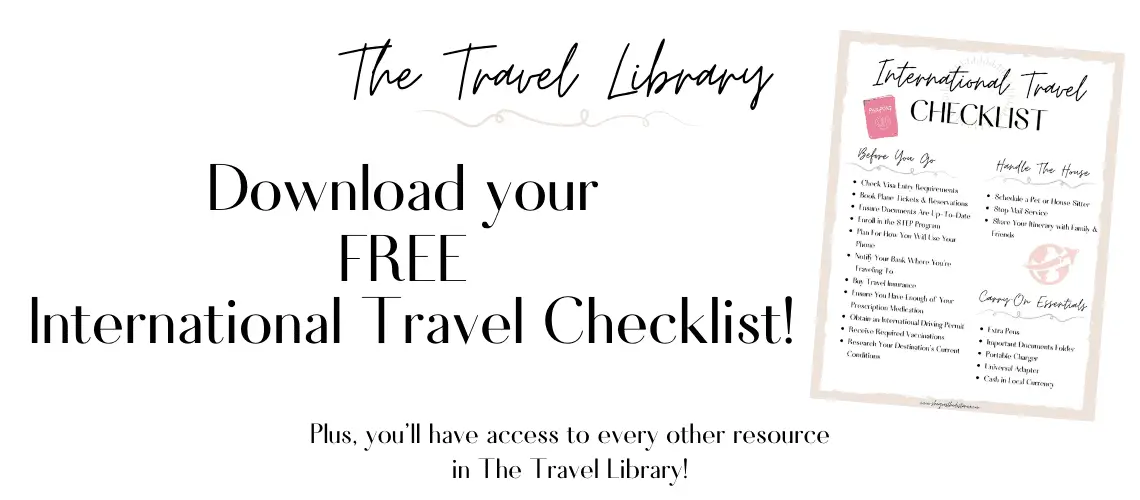
Step one is to convert this informative post into a handy checklist you can download and print as your international travel prep gets underway!
You will receive tons of information about preparing for international travel throughout this post, but if you’re looking for a quick and easy fix, you can jump straight to the downloadable checklist of the actionable steps you need to take.
It’s also a helpful handout to keep things organized as you’re preparing to go abroad – you have a lot to think about, so a printed list can at least streamline one aspect of your trip prep!
Not to mention you can download so much more, like a packing list or photo editing presets, since this checklist is part of The Travel Library .
Email address
Preparing for International Travel: Before Departure
1. check visa entry requirements for your destination.
The first thing you should do when preparing for international travel is update yourself if there are any visa requirements for entering the country with the passport you hold (I have the most experience with my US passport, so I’ll mostly be referencing travel as a US citizen.)
You can do a quick check for visa requirements by country and then contact the embassy covering your jurisdiction to proceed with applying for a visa if necessary.
2. Book Plane Tickets & Other Important Reservations In Advance
As soon as you know you’re leaving the country, start looking to book flights, accommodation, car rentals, and any other reservations that would be detrimental to your itinerary to not have planned.
Use my favorite cheap flight hacks to find a flight and keep in mind countries can be strict if you don’t have a return ticket home. Have some kind of proof of onward travel or your return plane ticket when going through customs.
3. Ensure Documents Are Up To Date
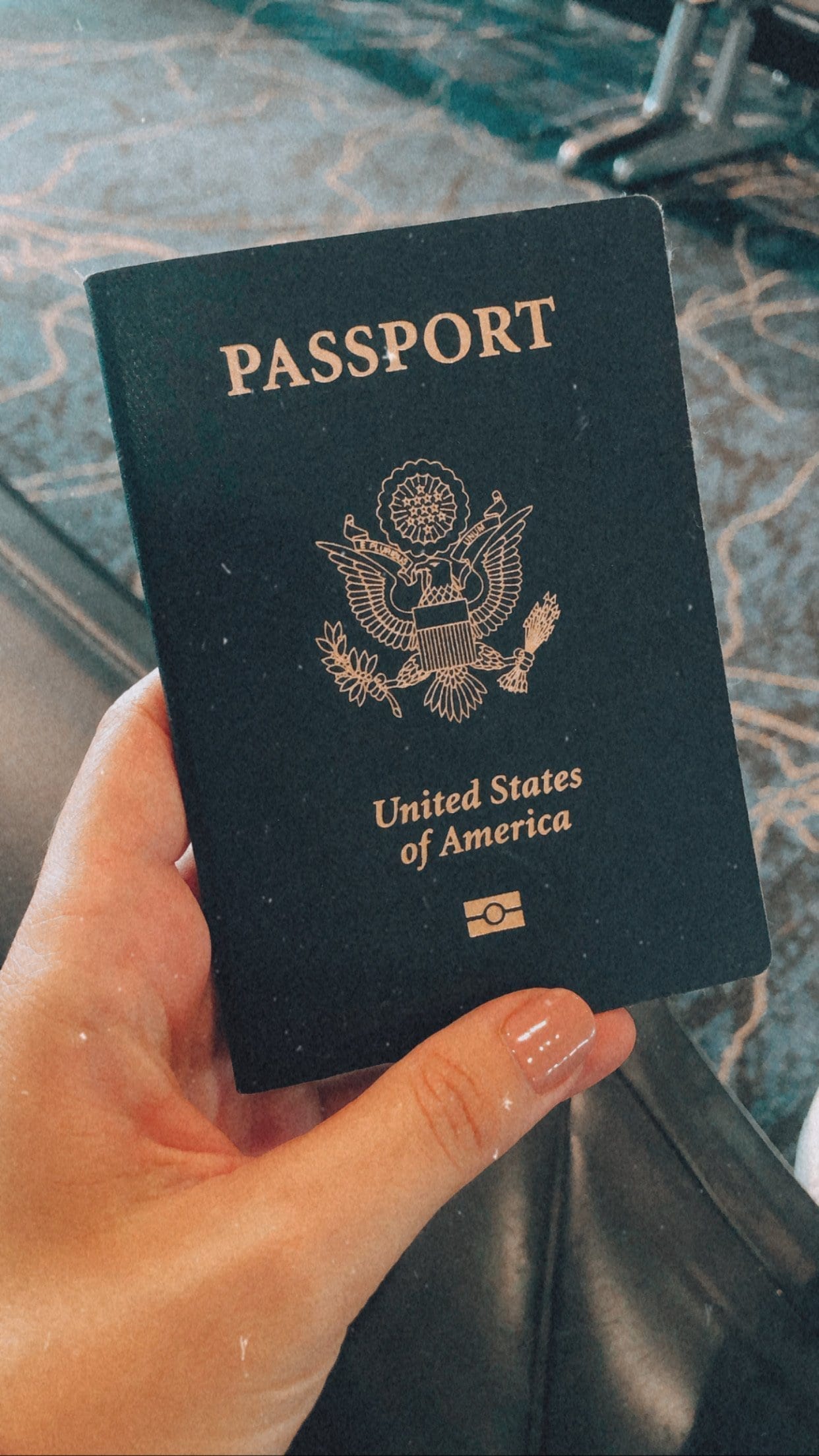
The most important document for international travel is your passport. Besides not losing it, you must make sure the document is not expired.
Passport renewals should be done as soon as possible if you realize your passport is expired before your next trip.
Another thing to keep in mind is that some destinations will not allow you in their country if your passport will expire within 6 months of your trip or if you don’t have enough blank pages.
4. Enroll In The STEP Program
United States citizens should always enter their trip information into the Smart Traveler Enrollment Program , offered by the US Department of State.
By entering your information, you will then be notified by email of any relevant safety news affecting your destination, including protests, emergencies, and embassy contact information.
If an emergency does occur, it makes it easier for the embassy to contact you and your family, so this is one of the most important things to do on this international travel checklist.
5. Plan For How You Will Use Your Phone
This has always been a big one for me – probably because I’ve been in countless situations where my phone doesn’t work while I travel!
You have several options for figuring out how you will use your phone abroad:
- Pay for your international phone plan through your domestic provider. (Typically expensive, but convenient)
- Only use free WiFi.
- Buy a local SIM card. (You can learn about the basics in my guide to buying a SIM card in Italy .)
- Pay for a WiFi roaming hotspot like Solis .
Depending on your budget and duration of your trip, some options are better than others. If you’re only abroad for a week, then I would just use free WiFi or pay for an international phone plan through my provider.
Anything longer and paying for a SIM card is way more worth it. The SIM takes a few days to activate, so even though it’s cheaper still than an international phone plan, it’s not very convenient for travels less than a week.
6. Notify Your Bank Where You’re Traveling To
Depending on your bank, you may have to submit a travel notification so they know what days and where you will be out of the country in order to not flag your purchases as fraud.
Also find out if the bank or certain credit card companies charge fees for international transactions.
7. Buy Travel Insurance
I typically never buy travel insurance, but going abroad is a different story. Not only is your trip abroad expensive, but your health insurance will likely not cover you for anything while you’re in a foreign country.
It is worth it to protect your trip and be prepared for any emergencies by investing in travel insurance. World Nomads has different policies for your needs and budget to keep you covered and have some peace of mind while traveling.
8. Ensure You Have Enough of Any Prescription Medication During Your Travels
Before embarking on your trip, order and pick up any medication or vitamins you will need for the duration of your trip.
Items like toiletries and clothes are easy to get abroad, but prescription medication is not something you want to forget.
Pro Tip: Always keep medicine in your carry-on in case your checked bag gets lost.
9. Obtain An International Driving Permit (If Necessary)

If you are planning to go on a road trip abroad, rent a car, or drive for any reason, then make sure to check if your US Driver’s License is valid in that country.
In most cases, you will have to get an International Driving Permit which is basically an authentication of your US Driver’s License.
Do this step several weeks in advance of your trip in case you have to wait for the permit by mail.
10. Receive Required Vaccinations (If Necessary)
The CDC has a feature to search for health information according to each destination around the globe. This includes current public health situations in the country and required vaccines, if any, upon entry.
11. Research Your Destination’s Current Conditions
What’s the weather like where you’re traveling to? Is there a holiday occurring during your travel dates? Asking yourself these questions and finding the answers will help you to avoid bumps in your itinerary as best as possible.
Being far away from home, you won’t have the same comforts and resources. Surprises like a national holiday where no stores are open or a train strike (yes, both of these happen in Italy where I live) can freak you out if you have to change around your travel plans!
Spontaneity is one of the most fun parts of traveling, but having a plan to be prepared can help you avoid sticky situations.
Handle Things at Home

12. Schedule a Pet or House Sitter
Taking a trip means you can forget about your troubles at home – well, not entirely. If you need your house taken care of or someone to watch a pet, get those services in order well before you leave for your trip.
Scheduling services last-minute can mean no availability, which creates a stressful situation, which we are trying to AVOID with this checklist!
13. Stop Mail Service
You’re on vacation, but your mail is not! If your mail piles up while you’re abroad, you run the risk of items stopped being delivered.
The US post office, for example, can usually hold mail up to 30 days . If you are traveling for longer than that, you may have to sign up for a forwarding service so your mail is received.
14. Share Your Itinerary With Friends & Family
The last step for handling things at home is to share your itinerary with someone staying behind. This tip is especially important for solo travelers, so friends and family can know where you’re supposed to be and when in case something happens.
You can share your detailed itinerary through apps like Wanderlog , where you can also update it as you travel.
At minimum, give loved ones or close neighbors an idea of where you’ll be and for how long so they can keep an eye out for things back home and know how to contact you if necessary.
It’s also to helpful to leave copies of documents like your passport with your family in case of emergency.
Carry-On Packing Essentials for International Travel
There are certain items you should always keep in your carry-on – medicine, valuables like jewelry, as well as an extra outfit (especially for international trips with connecting flights – you never know if you’ll be the unlucky one to have their luggage lost.)
Keep essentials easy-to-reach all throughout your airport experience. When you need to sign something or charge your phone, you don’t want to have to open up your suitcase and dig through your stuff at the airport gate trying to try and find a pen or charging cord.
Pro Tip: Take photos of your suitcases in case they get lost. It may assist the airline in recovering your lost bags quicker!
15. Extra Pens
It may be the simplest thing to cross off on this international travel checklist, but don’t forget to throw some pens into your carry-on bag or personal item.
On international flights, you’ll have to fill out customs forms and potentially other documentation based on the destination or airline. Always bring a pen with you and keep it accessible throughout your flight.
You don’t want to be stressed trying to ask neighbors for a pen or being unprepared for customs (they like to move quickly and efficiently.)
16. Important Document Folder
Especially when traveling alone and now in 2021 with COVID-related travel restrictions and rules still in place, I always carry an easily-accessible, closable folder that holds my important documents.
In this folder I’ll keep:
- Printed Boarding Pass
- Printed Itinerary
- Copies of any necessary documents like birth certificate, SSN, etc. (I only do this if I’m doing long-term travel, like study abroad)
- Visa Documentation
- Passport (I typically keep my passport in my WANDRD Backpack because it has a secret, unidentifiable pocket on the backside for anti-theft security)
- COVID-related Travel Documents – Proof of Vaccination, Proof of Negative Test, etc.
Keep the folder accessible for check-in and customs. You may also add customs forms to this folder along your journey to make sure you don’t lose them.
Pro Tip: Make sure to also take photos of important documents like your passport. If you lose it, it could help you get a replacement faster.
17. Portable Charger

I never leave for a trip – especially a long one- without my Anker Powercore Portable Charger . While traveling internationally, you never know what can happen.
You may have the wrong outlet adapter or the USB port in the plane cabin might not work and the last thing you want to do is be without a phone.
It may be the only place you have evidence of hotel reservations, transportation tickets, and moreover, where you can contact family and friends to tell them you’re safe.
The Anker portable chargers are the best brand I’ve come across, lasting me years, and worth the $60 in comparison to buying a cheap one that will stop working after a few charges.
Storytime! I once traveled to London for a weekend and on my return flight to Italy, the plane was stuck on the tarmac for SIX HOURS! I returned to Pisa eight hours late, having missed my bus back to Florence, and my phone had been dead for hours – which also happened to be the only place I had evidence of a bus ticket to try to get on the next bus. These are the kind of situations you want to avoid by always having a portable charger on you!
18. Universal Adapter
Along the lines of keeping your phone battery alive, you want to make sure you’re traveling with a universal adapter that will fit the plugs of the country you are traveling to!
No plug adapter equals no way to charge devices, use hair appliances, or power up whatever other electronics you travel with.
Most universal adapters are inexpensive and – as they say – universal, meaning they can work with a lot of different plug types. Make sure your destination is one of the plug types included before you purchase.
19. Cash in Local Currency
I personally prefer to use my card when I travel, but it depends on your destination and your bank’s policies if that’s a viable option for you.
For example, if your bank charges high fees for using your card abroad, then paying in local currency may be more economical. On the other hand, some destinations more than others are going to widely accept debit and credit cards.
Whether you wish to pay in cash or card throughout your travels, I recommend exchanging at least a couple of days’ worth in currency to ensure you have a backup method of payment in case of emergency.
Think about if you will need to take a taxi from the airport to your hotel and any purchases you may have to make as soon as you arrive in the country. The more things that fall into that category, the more money I would exchange into local currency.
Plus, if you forgot to notify your bank of your travels, you may not be able to take out cash from ATMs or your card may be declined.
Find out more about currency and using ATMs abroad before you go. Just remember, it’s always good to have a backup plan!
Final Thoughts
Traveling abroad is an incredibly rewarding experience. This international travel checklist covers all the serious stuff you need to take care of before your trip.
But it’s all so that you can avoid stressful situations and travel away from home with peace of mind!
I hope these tips were helpful and allow you to enjoy your international travel while being adequately prepared!
Any questions about the international travel checklist? Leave me a comment!
Save this checklist on Pinterest!

Michela is a travel writer and photographer living in northern Italy. She is passionate about helping people make the most of their travels by sharing advice gained from her personal experiences, off-the-beaten-path destinations and time-saving quick itineraries. Browse her top articles or have her help you plan your itinerary to your dream destination!
Find me on: Web | Instagram
You may also enjoy:
The beis luggage review you need to read before you buy: worth …, leave a reply cancel reply.
Your email address will not be published. Required fields are marked *
Save my name, email, and website in this browser for the next time I comment.
Website URL
Sign me up for the newsletter & access to resources from The Travel Library!
JOIN MY FACEBOOK GROUP

Check this out
- The Travel Library
- Privacy Policy
BUY ME A COFFEE
I love creating free resources for your travels and personally responding to your questions over chat and email.
Planning a trip to Italy?

Looking for Something?
- LATIN AMERICA & CARIBBEAN
- MIDDLE EAST
- US & CANADA
The Complete Beginner’s Guide to International Travel

So you’ve decided to travel internationally, have you? Traveling to another country is something I wish for everyone to experience at least once in a lifetime.
Unfortunately, not everyone has the privilege to do so. But for those of us with passports that allow us such opportunity, it’d be a shame to never explore an international destination in our great, big, beautiful world !
It might seem a bit scary to take your first international trip, but I promise it’s not that bad. To help you, I’ve put together this thorough guide on everything you need to know in order to have a successful international trip ! Let’s get straight to it.
Before You Depart for Your Trip
There’s quite a bit to get ready before your international trip. But, don’t worry. It’s all doable, and it’ll all be worth it!

Apply for a Passport
First things first. In order to travel internationally, you’ll need to have a valid, unexpired passport . On top of that, many countries require you to also have at least three or even six months validity left on your passport from your date of travel. So, if you don’t have a valid, unexpired passport or your passport is expiring in three to six months, it’s time to get a new passport before your trip. This process can take a couple months! So plan ahead, and submit your passport request early to save yourself stress and/or expediting fees closer to your departure date.
If this is your very first passport, your last passport was from when you were under 16 years old, your previous passport was lost, stolen, or damaged, or your last passport was from 15 or more years ago, you will need to apply for your passport in person. Here are the official steps for the new passport process .
If the above doesn’t apply to you, you simply have to renew your passport. You can do this via mail. Here are the official steps for the renewal process .
Choose Your International Destination
Yipee! Now that you’ve either already got your passport or have applied for a new one, you can choose your international travel destination. This is largely based on your own interests. But as this is your first trip internationally, keep in mind things like language, similarity in culture to back home, and ease of travel-related infrastructures (like trains or buses).
Apply for Any Visa(s)
Once you have chosen your destination(s), check whether you need visas or not . A visa is basically permission from a foreign government for you to be in their country. Some countries may grant you a free visa upon arrival with a simple stamp on your passport. Some countries simply require you to fill out a form online and pay a small fee before you can board your flight. And some countries require expensive visas which you must apply for months in advance. It all depends on that country you are visiting, your passport country, and how long you plan to stay. I love using Travisa ‘s free search tool to quickly and easily check what requirements exist for me before I book a flight.
Get Any Necessary Vaccines
Before confirming your destination, you should check if any vaccines are necessary for that place. Some vaccines are simply recommended for your own health, while others are requirements before you will be allowed into the country , or even allowed into other countries afterwards (like yellow fever). The CDC website is an easy way to check this. Some vaccines, like yellow fever, are low in supply and hard to get last minute. Others, like malaria pills, require a doctor’s prescription. So don’t leave this step until the last minute !
Check Travel Restrictions
Lastly, make sure there are no travel restrictions or decision-altering political tensions for your destination. Do this by checking the Travel Department site . Simply type in your destination country’s name into the search bar on the left hand side of the screen.
Preparing Your Finances
Now that your passport is on its way and you’ve settled on your international travel destination(s), it’s time to start thinking about finances.

Some destinations are very credit card friendly. Others operate on only cash and debit cards. And some don’t even have ATM machines! So you’ll need to do a bit of planning before departure to make sure you’re not stressing during your trip, and to save yourself transaction fees.
Get a No Fees Credit Card
Most banks charge a 3% fee every time you use your credit card to pay for a foreign transaction. As you can imagine, this adds up to a lot over the course of even a one week international trip. The good news is, many banks offer credit cards without foreign transaction fees . Do a quick internet search to see if your bank offers such a card.
Get a No Fees Debit Card
Most banks charge a 3% fee and $5 each time you withdraw foreign currency from an ATM. Especially if you are traveling to a mostly-cash destination, this is a surefire way to rack up unnecessary travel costs. To avoid this, consider opening a free brokerage account with Charles Schwab to also receive their debit card with zero transaction fees . I first heard about this card when moving to London to study abroad, and I have to say it’s served me well.
Get Foreign Currency Beforehand
Sometimes, but not often, it’s necessary to have cash in your destination’s currency either before you depart home or right when landing . This might be because your destination does not have ATMs, or because you just want to feel prepared.
If you need foreign cash before leaving home, head to your local bank and exchange currencies. (Just FYI, you’ll get a bad conversion rate doing this, since the bank needs to make commission.) If the currency you need isn’t a common one, your bank won’t have it on hand. In that case, you’ll have to request the exchange online with your bank.
Many countries that don’t have ATMs also don’t allow their currency to be taken outside their country (like Cuba). In this case, you’ll need to bring enough cash with you in a common currency (like USD, GBP, or Euro). Then, when you arrive at your destination’s airport, you can exchange your cash from home for the local currency.
Sign Up for Airline Rewards Programs
You might already know this if you fly domestically, but most airlines have rewards programs. These allow you to accumulate “miles” in your rewards account each time you fly. Eventually, you might rack up enough to redeem those miles in exchange for a flight !
Consider Travel Hacking
Now, some people use airlines rewards programs and racking up miles on steroids, and this is called travel hacking. Many airlines and banks offer huge amounts of miles when you sign up for a card, or offer miles every time you use that card for a purchase. This allows you to rack up enough miles for a free flight or hotel stay more quickly (or sometimes immediately!). I personally have no energy for travel hacking, as I’m not convinced the miles rewards are worth more in dollars than my current card’s cash reward system. But I would be amiss to not mention travel hacking in a guide to international travel.
Planning Your International Trip
Phew! Now that you’ve got all the annoying administrative work out of the way, it’s time for the fun stuff; planning your trip .

I have a whole ten-step guide to planning a trip , so I won’t go into too much detail here. But this can be broken down into planning out your travel itinerary, booking your flight, and booking your accommodation.
Create Your Dream Itinerary
Decide everything you want to see in that destination. I love using Pinterest , Instagram , and travel blogs for inspiration. This is my favorite part of planning a trip , because it gets me so excited about what’s to come! Then, figure out how many days each spot deserves if you are moving around, and figure out how to get from point A to point B (train, cab, ferry?).
Book Your Flight
After you’ve decided how many days you need, you can decide what your travel dates are and start looking for a flight. You can sometimes find good deals really close to the date, but that isn’t guaranteed. I recommend not leaving this until the last minute! I go into more detail how I search for cheap flights in my trip planning guide .
Book Your Housing
Once you have your flight booked, all that’s left is your housing. I love using Booking.com because of its interface, but any hotel search engine will suffice. Also consider AirBnB if you like the idea of staying in a local apartment, or Hostelworld if you’re looking for a social (and often budget-friendly) option. I go into more detail on different types of travel accommodation in my trip planning guide .
Here are some discounts if it’s your first time using AirBnB or Booking.com:
- Save 15% off your first booking by using this link to sign up for AirBnB for the first time.
- Get 10% back from your first booking when you use this link for your first time using Booking.com.
Preparing for Departure
Woohoo! You’ve got your passport, your trip is planned, and all that’s left is to depart. There are a couple things you should do to best prepare for your upcoming international trip.

Scan the Front Page of Your Passport
Before leaving home, make a copy of the front page of your passport (the page with your picture). Either print it out or send it to yourself via email. In case your passport gets lost, stolen, or damaged during your international trip, this makes it easier to have your passport replaced abroad at an embassy.
Expect Cultural Differences
Every country or region has its own culture and norms, and that’s what makes traveling so great. In some places, like the US, it’s common to greet strangers “hello,” or for shop associates and waiters to be extra doting. In other places, like much of Europe, the slower cafe and restaurant culture means your waiter might not come to you unless beckoned. It’s almost seen as if the waiter is rushing you! Similarly, in Japan, it’s offensive to tip waiters, as it suggests their only incentive to do their job well is receiving your pocket change. No culture is right or wrong, but keep an open mind as you travel, and don’t assume something means the same as it does back home .
Prepare for Language Barriers
Many popular travel destinations have adopted English as a common language due to how many international tourists they receive. So, if you know English, chances are you’ll be fine getting around many travel destinations around the world. But it still doesn’t hurt to learn some basic words in your destination’s language .
Saying “hello” or “thank you” in a person’s mother tongue can go a long way in warming them up towards you. Learning common menu items or words on train station signs will also likely make your life easier and give you more confidence abroad. I love using the free version of Duolingo’s mobile app ( iOS and Android ) for a few weeks before I head somewhere new to learn a language’s basics. Alternatively, you could simply head to Google translate and jot down key words on a small piece of paper before you depart. Then, keep this paper handy while you’re out exploring for easy access.
What to Expect on an International Flight
Even if you’ve flown domestically before, flying internationally can be a whole different experience . Here are my top tips for flying internationally.

What to Pack in Your Carry On
Packing carry on luggage for an international trip is similar in many ways to for a domestic trip. The same rules apply with regards to liquid sizes and electronics. However, as international flights tend to naturally be longer than domestic flights, there are a few extra considerations.
Make sure you are comfortable. Bring your own favorite headphones instead of using the uncomfortable free or for sale ones on board the flight. Also bring an eye mask (and a neck pillow if you need that) so that you can try to sleep a bit. You’ll also want to pack clothing items like one pair of pajamas and one or two proper outfits, in case your luggage is lost or delayed . It would be super inconvenient to buy these things right after you land in a foreign country!
Common Flight Etiquette
No one likes flying. So to make it easier on everyone, here are some best practices for being polite while in the airport and on the plane.
- While in the airport, don’t stand up and crowd around the gate way before your boarding group is called. Everyone will get their chance to board.
- Once on the plane, the middle seat person gets dibs on the inner arm rests .
- Right after the plane lands, don’t rush to pull your luggage from the overhead before the plane doors have even opened (especially if you’re in the back of the plane!). If you’re in a rush to catch a connection you think you might miss, ask the flight attendants before landing if they can help you get off first. Sometimes they’ll make an announcement that everyone should stay seated until those about to miss a connection exit first!
Staying Healthy While Flying
The last thing you want is to get off your flight and feel unwell the first days of your epic trip! Here are precautions you should take to ensure you land in tip-top shape.
- Stay hydrated . Airplane air has less humidity (only about 10 – 20%!), so make sure you are drinking enough water, especially on long haul flights. I always bring a large, refillable water bottle when I fly. I fill it up at an airport water fountain right after passing security and finish it all before boarding. Then, I refill it again to have a full supply while on board. This is important not only for headaches and such, but also to prevent skin breakouts in the days after landing.
- Keep the blood flowing . Not only are you not moving for hours upon hours when flying internationally, but your feet are flat on the floor the entire time, too. This isn’t great for blood circulation, and can cause swelling in your ankles and feet the days after your land. (It’s also just not good for your health to not move!) So, make it a point to get up and walk around the plane. Since you’ll be drinking a lot of water anyways, maybe walk up and down the aisles for some minutes each time you finish using the toilets. Do some stretches , like pulling your feet up to your booty one at a time and holding, or lifting each knee up and holding. If you have a layover with enough time, walk around the terminal for some time before boarding your second flight.
- Stay clean . Even pre-Covid-19, planes and airports have never been the cleanest places to be. Wash your hands frequently with soap, use hand sanitizer , and consider disinfecting your food tray, screen, and arm rests right after getting on board. Make sure not to touch or pick your face too much, especially since it’s already dealing with the dehydrating air!
Flying with Dietary Restrictions
Airplane food is pretty much never great, especially if you aren’t flying first class. But if you’re on a particular diet or have dietary restrictions, you’ll need to plan ahead of time. Consider packing some of your favorite nutritious snacks instead of relying on the salty pretzels you can expect on board. If you have a specific need, like vegan meals, call the airline 24 hours before your flight to put in your request for a special meal . You might also want to double-check the meal request before take off at the gate.
Staying Safe While Traveling Internationally
While the world isn’t the big, bad, scary place we’re often made to believe, that doesn’t mean travel is free of risks.

A lot of the safety precautions and considerations you should take while traveling abroad are similar to those you take at home. But a few aren’t. Here are my main safety tips for international travel.
Solo Travel
By its very nature, traveling alone is more risky than traveling with a companion. Is it significantly more risky? I think not. But that’s not to say you shouldn’t take any extra precautions when traveling alone.
One precaution I take is to always let someone know where I am . If I have a full itinerary planned, I send my mom a summary of each city and accommodation I plan to stay at. If I’m doing something like a hike without any new friends I’ve met, I’ll let the front desk know my plans before I head out. I also try to be confident . Even if I don’t know where I’m going, I try to look like I do! If I need to look directions up on my phone, I might do it before leaving the hotel or shop or restaurant.
Another thing to remember is that traveling solo is not traveling alone . Especially if staying in hostels, you’ll meet other people traveling solo like you are, and you can do activities with them.
Solo Female Travel
Something my loved ones tell me often is how it’s so unsafe to travel alone as a woman. But the truth is, is it perfectly safe to be a woman anywhere in the world? Even when I’m in in the comfort of my home country, I rush to my car when in public garages at night, receive uncomfortable comments from strangers on the street, and face the potential of sexual harassment or even assault. Sexism exists everywhere, not just abroad. Of course, I do take extra precautions as a solo female traveler compared to a male solo traveler. But I also take extra precautions as a female in my home country, too.
These are some of the precautions I take while traveling as a woman, in addition to the precautions I take for traveling solo in general:
- I never walk alone past dark . Ever, ever. Even if I “feel” safe in a place (which is most of the time), it’s just something I’ve promised myself I wouldn’t do.
- I try to dress conservatively in certain destinations. Especially as a Californian, I’m used to super short shorts and low-cut shirts being totally normal. While these are still often acceptable abroad, they definitely cause a lot of stares that I personally have decided I’d rather avoid if I can. So, I’ll wear looser, longer shorts instead of tight short-shorts, or midi skirts and dresses instead of what I consider normal length. This isn’t so much because I feel unsafe, but because I’ve realized it decreases bothersome male comments and advances immensely.
- I haven’t actually done this yet, but it’s a trick I have in my back pocket. Bring a fake wedding ring . Depending on the destination, this can help ward off some comments (and even playful marriage proposals!).
Traveling as a Person of Color
Similar to the solar female travel issue, a lot of my family fear that I’ll stand out like a sore thumb as a black woman. Also similar to the solo female travel issue, racism is simply something that exists everywhere, not just abroad . Of course, I do take extra precautions as a black solo traveler compared to a white solo traveler. But I also take extra precautions as a black person in my home country, too.
The main extra consideration I take while traveling as a person of color is to research the experiences of other black people or black women in destinations I know less about , or that I know have few black people or tourists. I recommend you do the same for whatever race or ethnicity you might identify with, as destinations might be used to one group but not a different group. This, of course, can be difficult, as the voices in the travel sphere are mostly white men, and next white women. (This is why it’s important to have better representation.) If you can’t find the insight you need online, consider directly emailing or messaging any travel writers or influences whose experiences you’d like to hear.
Traveling with Cash and Valuables
Like you would in certain areas of your home country, don’t flash valuables while traveling. Be cognizant as you withdraw or exchange any cash . Being a tourist can make you a target already, so don’t give pickpockets any extra incentive!
Be careful not to carry all your cash and cards in one place. If you can, take some with you as you explore, and then leave back up cards, unneeded cash, and your passport back in a safe in your accommodation . That way, if anything gets stolen or lost while out exploring, you have back ups to hold you over.
Bring Locks for Hostels
If you are planning on staying in hostels, definitely purchase a lock before your trip. Hostels usually have lockers, but charge a couple bucks to rent a lock. It’s much more economical to purchase once and not pay each time.
Register with Your Country’s Embassy
This is a step I never usually did before, but one I’ll be doing every time in the future! I was “one of those” people who got stranded abroad in a foreign country when the world started closing borders in response to Covid-19. I always thought registering with the local embassy for my country was a waste of time, but this turned out to be the best way to get up-to-date information on the situation. After missing out on crucial info once, I signed up. And it’s thanks to that I was able to eventually get home!
You never know what could happen when you are abroad, whether that is a pandemic, weather-related disaster, local protests, or political tensions. It’s near-impossible to keep up with your foreign destination’s news while traveling. So registering with your embassy is an easy way to get a simple email for key things you should know . For Americans, this program to register is called the Smart Traveler Enrollment Program (STEP) , but other countries have pretty much the same thing.
Get Travel Insurance
I’m not sure I believe “everyone” should “always” get travel insurance. But for a first trip abroad, it’s worth considering. I typically never purchased it when I traveled places I knew well. But these days, as I’m no longer on my parents’ good insurance, and as I travel mostly solo, I do purchase travel insurance. It often only costs a couple dollars a day , and usually covers lost baggage, medical visits for accidents or illnesses, theft, and more. Especially if you are planning adrenaline activities or traveling somewhere distant, you should consider it!
What Do You Think About My International Travel Guide?
And there ya have it, folks! Are you feeling prepared for your international trip! I hope this guide was helpful. If you still have more questions before your trip abroad, definitely comment below and I’ll answer. Or, if you have any advice you think I missed that others should know, please also comment below!
Save This Guide to Return to Later on Pinterest

Further Reading...

How to Travel Cheaper: A Beginner’s Guide to Budget Travel

The Beginner’s Guide to Staying in Hostels

Complete Guide to Flying RyanAir (& Not Getting Ripped-Off)
No comments, leave a reply cancel reply.
Save my name, email, and website in this browser for the next time I comment.
This site uses Akismet to reduce spam. Learn how your comment data is processed .
13 Top Attractions and Things to Do in Vienna, Austria
25 top attractions and things to do in san francisco, that travelista.

12 Tips to Prepare for an International Trip
Tips for take-off to landing
Going on an international trip soon? The rules for international flights have many dos and don't's. Here are 12 tips gleaned from experienced globe trotters designed to make that long-haul flight easier.
Pack Lightly
On one of my first international business trips as an adult, I overpacked drastically. Guess who had to carry a large heavy suitcase, a large purse, and a garment bag around Paris at Metro and train stations that didn’t have elevators or escalators? After that, I swore to only pack what I could comfortably carry by myself. Check out my packing tips here.
Choose an Aisle Seat
On long flights, it’s recommended that you get up and walk to stretch your muscles and avoid blood clots in your legs. This is much easier to do in an aisle seat, so book one as soon as you book your ticket.
There's an App for That!
Apps can be a savior when traveling, but especially when you're abroad. You can use travel apps them to keep in touch with your airline, translate different languages, search for services at airports, choose your seats and myriad other tasks.
Dress Accordingly
On a long flight, you want to look well-dressed, but you also want to be comfortable. so you don’t want to wear clothes that cut or bind. I wear a wrinkle-proof jacket that can double as a blanket or a pillow, and I always wear a long pashmina for the same reason. The pashmina can also be used as a wrap, a pillow, a skirt cover and an accessory to dress up travel outfits. Buy my favorite for $10 at the Bijoux Terner website. I also wear slip-on flat shoes that are easy to take on and off at security and on your flight. All of this isbeautifully illustrated here at the Chelsea Tells Storiesblog.
Arrive Early
Most airlines want you at the airport at least two hours before your flight takes off, especially if you’re leaving from a U.S. international gateway airport . It will give you time to check your bags, check in, navigate the airport security checkpoint and get to your gate in plenty of time and arrive stress-free.
Zip Through Customs
Those who travel internationally know that U.S. Customs and Immigration lines can be a nightmare, especially at peak arrival times at the major international U.S. airports. Smart travelers carry the Global Entry card, which speeds you right past the Immigration and Customs lines. And a bonus -- it also works for the domestic Transportation Security Administration's PreCheck program .
Lounge Around
Because you need to be at the airport so far in advance, consider paying for access to an airline-branded or airport lounge. There are plenty of lounges that allow you to pay a fee for entry. It's good to have time away from the masses before boarding your flight.
Drink Water
It’s OK to have a glass of wine or two while on your flight, but you really need to stay hydrated, because aircraft cabins are extremely dry. And instead of bothering flight attendants for endless little cups of water, go to your local dollar store, buy a water bottle and ask them to fill that up.
Cone of Silence
Nothing is worse than being on a plane with a screaming child or a chatty Cathy seatmate. That’s why I never travel without either a pair of noise canceling headphones or my Beats Flex By Dr. Dre earbuds. Pop on either of them and enjoy the silence.
Sleepy Time
When it’s time to rest, you want to be comfortable. So invest in an inflatable neck pillow (I know they look silly, but they are a great sleep enhancer), an eye mask and comfortable socks.
Charge Me Up
More airlines are installing power ports on their aircraft, but you can’t always depend on that. When I flew to Paris for Christmas, the flight over had a USB port, but the flight home didn’t. That’s why I always carry mytrusty Mophie Juice Pack Powerstation Duo, which allows me to charge my iPhone and iPad quickly.
Show The Love
The flight attendants are there for your safety. But they also work hard to ensure that our flight is comfortable and stress-free. Show your appreciation by presenting them with a box of sealed chocolates, like Ghiradelli Chocolate Squares or Ferrero Rocher truffles. And although you're not expecting it, they may show the love back to you in return.
15 Tips to Make Airline Connections Smoother
The 11 Best Carry-on Backpacks of 2024, Tested and Reviewed
10 Long-Haul Flight Survival Tips and Tricks
What It’s Like to Fly Halfway Around the World During the Pandemic
How to Prepare for Long-Haul Flights with Kids
Best Ways to Prepare for Airport Security Screenings
The 9 Best Travel Pillows of 2024, Tested and Reviewed
What to Pack in Your Carry-On Bag When Flying with Kids
Small Air Travel Upgrades You Can Totally Afford
Car Seat Policies for the Top 15 North American Airlines
How to Get a Free Upgrade From an Airline
Baggage Wrapping Service Offers Peace of Mind for Air Travelers
8 Air Travel Rights You Didn’t Know You Have
How to Travel Internationally With Your Pet
9 Tips for Traveling With Kids During the Pandemic
Is Premium Economy Worth the Splurge? On These Airlines, the Answer Is Yes

An official website of the United States government
Here’s how you know

Official websites use .gov A .gov website belongs to an official government organization in the United States.
Secure .gov websites use HTTPS A lock ( Lock A locked padlock ) or https:// means you’ve safely connected to the .gov website. Share sensitive information only on official, secure websites.

- Trusted Traveler Programs
- Global Entry
- How To Apply
How to Apply for Global Entry
It’s easy. just follow these steps..
Before applying, make sure you are eligible for Global Entry .
Create a Trusted Traveler Programs (TTP) account
Regardless of your age, you must have your own Trusted Traveler Programs (TTP) account.
Log in to your TTP account and complete the application
A $100 non-refundable fee is required with each completed application.
Schedule an interview at a Global Entry Enrollment Center
After accepting your completed application, CBP will conduct a review. If your application is conditionally approved, your TTP account will instruct you to schedule an interview at a Global Entry Enrollment Center . Each applicant must schedule a separate interview.
Complete the application process
Bring your valid passport and one other form of identification, such as a driver’s license or ID card, to the interview. If you are a lawful permanent resident, you must present your machine readable permanent resident card.
Non-Refundable Application Fee
A $100 one-time fee is required with your Global Entry application and must be paid at time of application submission through the Trusted Traveler Program (TTP) system. You can pay by credit card or through an electronic bank transfer.
The fee is non-refundable, even if an application is denied.
An official website of the United States government
Here’s how you know
Official websites use .gov A .gov website belongs to an official government organization in the United States.
Secure .gov websites use HTTPS A lock ( Lock Locked padlock icon ) or https:// means you’ve safely connected to the .gov website. Share sensitive information only on official, secure websites.

Visas for U.S. citizens traveling abroad
If you are a U.S. citizen planning to travel abroad, you may need a visa to enter a foreign country. Learn how to find your destination's visa requirements.
While not all countries require visas for American travelers, many do. Look up your destination using the U.S. State Department's Learn About Your Destination search tool . On the country’s information page, you will find entry, exit, and visa requirements. You will also find travel advisories and a link to the country’s embassy.
LAST UPDATED: December 6, 2023
Have a question?
Ask a real person any government-related question for free. They will get you the answer or let you know where to find it.
What’s the best international phone plan right now?

On my first trip to Japan, I decided to forgo international data on my cellphone. I figured I could rely on public Wi-Fi, but I regretted not having data on my phone when I became lost. From that experience, I learned to download offline maps and a translation app beforehand if I know I won't have data.
But now, I almost always have data when I travel via my international phone plan, or through a physical SIM I buy at my destination or an eSIM I purchase online.
There are many reasons why you may want to remain connected while abroad. In this guide, I'll compare the best international phone plans. Note that many plans function differently in Canada and Mexico from other international locations. This guide focuses on the best phone plans for U.S. residents who travel outside North America.

First things first: You might not need an international phone plan. If you primarily need data, using a different SIM on your trip may be the simplest and cheapest solution. Some apps even support text and voice communication over data connections.
If your device supports eSIM, you may be able to purchase a data plan for your destination through an app like Airalo . Over the past year, I've purchased and used the following Airalo eSIMs either to gain data in a destination not served by my primary international phone plan (Google Fi) or to get less-expensive data than what Google Fi provides:
- Global (84 countries) : 20 GB over 180 days for $89
- Japan : 20 GB over 30 days for $26
- France : 20 GB over 30 days for $36
- Fiji : Three GB over 30 days for $19.50
- U.S. : One GB over seven days for $4.50
If your device doesn't support eSIM, you could still purchase a local SIM card at your destination. For example, I bought a monthlong SIM card with unlimited high-speed data in Vietnam for less than $10. But data is significantly more expensive in some destinations, and it can be difficult to determine exactly what you're getting when you purchase a physical SIM card. As such, I've mostly stuck with a physical Google Fi SIM card and Airalo eSIMs instead of using local SIM cards.
If you plan to use eSIM or a local SIM card, you should ensure your phone is unlocked. A locked phone won't be able to accept any other SIM cards until it is unlocked.
Related: How TPG's Zach Griff avoids the pesky $10 daily roaming charges when traveling

- Cost for one line : $20 (plus taxes and fees) per month plus data usage costs for the Flexible plan or $65 (plus taxes and fees) per month for the Unlimited Plus plan
- Data abroad : $10 per GB (with free data after six GBs per month but slower speeds after 15 GBs in a month) in more than 200 destinations for the Flexible plan or free (but with slower speeds after 50 GBs in a month) in more than 200 destinations for the Unlimited Plus plan
- Voice abroad : 20 cents per minute from more than 200 destinations (and calls via Wi-Fi to the U.S., Canada and Mexico are free)
- Text abroad : Free from more than 200 destinations
I've used Google Fi as my primary cellphone plan for most of the past six years. I've had a few connectivity issues in the U.S. — where Google Fi currently uses the T-Mobile network — including in Tampa, Austin and New York City. However, I keep Google Fi primarily because I usually get high-speed data as soon as I turn airplane mode off, and I can seamlessly receive calls and texts on my U.S. number while traveling internationally.
You might be tempted to only use Google Fi when traveling outside the U.S., but doing so isn't a good idea. After all, the Google Fi terms of service state:
The services are offered only to residents of the United States. The Services must be primarily used in the United States (territories not included) and are not intended for extended international use. Further, the services are designed for use predominantly within our network. If your usage outside our network is excessive, abnormally high, or causes us to incur too much cost, we may, at our option and sole discretion, suspend your Google Fi account, terminate your service, or limit your use of roaming.
Google Fi has shut down some U.S. residents who used Google Fi primarily outside the U.S. So, I recommend avoiding extended international use and using Google Fi more in the U.S. than abroad if you don't want to get shut down. I buy eSIMs to decrease my Google Fi usage in some destinations, especially when I can purchase a package through Airalo for significantly less than $10 per GB (the amount I pay Google Fi for data on my Flexible plan).
Google Fi is the best international phone plan for U.S.-based travelers who want fast data without hassle while traveling abroad. Plans become slightly cheaper as you add more members. In my travels with Google Fi since 2016, I've only failed to get any service in three locations: parts of Alaska, the all-inclusive resort I lived out of for a month in the Dominican Republic and Liberia .
Related: Can you use your cellphone on a cruise?

- Cost for one line : $60 per month for the Essentials plan, $70 per month for the Magenta plan, $75 per month for the Go5G plan, $85 per month for the Magenta Max plan and $90 per month for the Go 5G Plus plan
- Data abroad : Free for up to five GB of high-speed data (in 11 European countries for the Magenta and Go5G plans, and in more than 215 countries and destinations for the Magenta Max and Go5G Plus plans) and then free for up to 256 kilobits per second in more than 215 countries and destinations for Magenta, Go5G, Magenta Max and Go5G Plus plans (no data outside North America is included in the Essentials plan)
- Voice abroad : 25 cents per minute from more than 215 countries and destinations for the Essentials, Magenta, Go5G, Magenta Max and Go5G Plus plans
- Text abroad : Free from more than 215 countries and destinations for the Essentials, Magenta, Go5G, Magenta Max and Go5G Plus plans
Before using Google Fi in 2016, I relied on T-Mobile when traveling internationally until I grew tired of slow data speeds. However, the plans have improved, and many travelers swear by T-Mobile as their international phone and data plan . T-Mobile customers can avoid slow data by purchasing international passes to add to their existing plan as follows:
- International 1-day pass : 512 MB of high-speed data and unlimited calling for 24 hours for $5
- Five-GB international pass : Five GB of high-speed data and unlimited calling for 10 days for $35
- 15-GB international pass : 15 GB of high-speed data and unlimited calling for 30 days for $50
Long-term and frequent international travelers should note that T-Mobile says the following about its plans:
Not for extended international use; you must reside in the US and primary usage must occur on our network. Device must register on our network before international use. Service may be terminated or restricted for excessive roaming.
Additionally, T-Mobile's terms and conditions state you are not permitted to use T-Mobile services if it "results in more than 50% of your voice and/or data usage being Off-Net (i.e., connected to another provider's network) for any 2 billing cycles within any 12-month period." There have been instances of T-Mobile shutting down travelers for roaming excessively . So, don't go with T-Mobile if your primary usage won't be domestically on T-Mobile's network.
Related: 6 reasons why Apple's entry-level iPhone 14s are great for travelers
Other international phone plans to consider

Finally, you may want to check your current provider's options if you only occasionally travel internationally. Here are some options that are available as optional add-ons for many AT&T and Verizon plans:
- AT&T international day pass : Pay an extra $10 per 24 hours for unlimited high-speed data, talk and text in more than 210 destinations. You'll only be charged for days (as determined by your local U.S. time zone) you use data, make or receive a call or send a text message while in a destination covered by the international day pass.
- Verizon TravelPass : Pay an extra $10 per day per line for unlimited calls, texts and data (data speeds decrease after two GBs in a day) in more than 210 countries. You'll only be charged for days you send or receive a call, send texts or use data while abroad.
- Verizon international monthly plan : Pay an extra $100 per month for 250 minutes of talk, unlimited texts and unlimited data (data speeds decrease after 20 GBs in a month) in more than 210 countries.
You could also check out U.S. Mobile's plans. U.S. Mobile plans don't include calling or texting from outside the U.S. Still, the Unlimited Premium plan offers up to 10 GB of international data, and most plans let you buy eSIMs for more than 100 countries from within the U.S. Mobile app.
Mint Mobile could also be a viable solution if you're on a budget and don't travel abroad frequently. Although Mint Mobile doesn't offer any international data, text or voice on its plans, you can purchase international roaming credits and then use them to text, talk and use data in more than 210 countries and destinations. Rates for talk, text and data vary based on the country you're visiting; they usually cost about 25 cents per minute for talk, 5 cents per text and 20 cents per MB of data. If you don't plan to use much data — after all, you'd be paying a massive $205 per GB in many countries — Mint Mobile could be a feasible option.
Most cellphone plans allow you to pay as you go for international use, but these rates are almost always excessive. As such, frequent international travelers should find a different solution because pay-as-you-go costs will add up quickly.
Related: Credit cards that cover cellphone loss and damage
Bottom line
Having a functioning international phone plan when traveling abroad is important for travelers who want to stay connected. Traveling as a digital nomad , I've found Google Fi is by far my best option for fast data, modestly priced calling and free texting in most destinations. However, I supplement my Google Fi plan with eSIMs in some destinations to gain access to less-expensive data.
If you already have T-Mobile or a plan that offers international add-ons, you may want to stick with your plan. Otherwise, it's worth considering an eSIM or a local SIM card. You can buy eSIMs ahead of your trip, and it's usually possible to pick up local SIM cards at the airport when you land in a new country.
- Election 2024
- Entertainment
- Newsletters
- Photography
- Personal Finance
- AP Investigations
- AP Buyline Personal Finance
- Press Releases
- Israel-Hamas War
- Russia-Ukraine War
- Global elections
- Asia Pacific
- Latin America
- Middle East
- Election Results
- Delegate Tracker
- AP & Elections
- March Madness
- AP Top 25 Poll
- Movie reviews
- Book reviews
- Personal finance
- Financial Markets
- Business Highlights
- Financial wellness
- Artificial Intelligence
- Social Media
As international travel grows, so does US use of technology. A look at how it’s used at airports
Piet De Staercke, from back right to left, with his wife Jill Bornauw, their eldest son Stan De Staercke, watch their youngest Tuur de Staercke, get screened by a Custom Border Protection officer, right, in the port of entry at Washington Dulles International Airport in Chantilly, Va. Monday, April 1, 2024. The Belgian family of four, used the Mobile Passport Control app, the newest technology in international travel, to ease their way to their port of entry. Within minutes they had bypassed a long line of people waiting at the airport’s passport control and were waiting for their luggage. (AP Photo/Manuel Balce Ceneta)
International travelers not using the Mobile Passport Control app, stop and use the portal to get their initial processing and instructions on their next procedure, in the port of entry at Washington Dulles International Airport in Chantilly, Va. Monday, April 1, 2024. A Mobile Passport Control app user can bypass this procedure and go straight to a Custom Border Protection officer for processing easing their way to the port of entry. (AP Photo/Manuel Balce Ceneta)
A Custom Border Protection officer, right, puts his thumb up as Tuur de Staercke, left, gets screened in the port of entry as his family watches at Washington Dulles International Airport in Chantilly, Va. Monday, April 1, 2024. The Belgian family of four, used the Mobile Passport Control app, the newest technology in international travel, to ease their way to their port of entry. Within minutes they had bypassed a long line of people waiting at the airport’s passport control and were waiting for their luggage. (AP Photo/Manuel Balce Ceneta)
International travelers go down the escalator to get processed at the port of entry at Washington Dulles International Airport in Chantilly, Va. Monday, April 1, 2024. (AP Photo/Manuel Balce Ceneta)
- Copy Link copied

WASHINGTON (AP) — The Belgian family of four was on their fourth trip to the United States. They had been dreading the long line at passport control when they entered the country but had heard about a new app they could use to ease their way and decided to give it a shot. Within minutes, they had bypassed the long line at Washington Dulles International Airport and were waiting for their luggage.
“It was always a long row,” said Piet De Staercke of the line to go through passport screening. He, his wife and two sons were visiting Washington and Chicago. “We were a bit scared. But now with the app, it’s amazing.”
As travel continues to boom following coronavirus pandemic-related slumps, U.S. Customs and Border Protection is expanding the use of technology like the Mobile Passport Control app the De Staercke family used in an effort to process the ever-growing number of passengers traveling internationally. And with events like a rare solar eclipse , the Olympics in Paris, and summer holidays still driving international travel, those numbers don’t look set to drop anytime soon.
Customs and Border Protection officials gave The Associated Press a behind-the-scenes look at some of the technologies they’ve been using and what to expect in the months and years ahead.
THE NUMBERS
During fiscal year 2023, the agency processed over 394 million travelers at the ports of entry. That’s a 24% increase over the previous year. When looking at the country’s top 20 airports by passenger volume, officers processed 31% more travelers while average wait times increased 11%. And at some of the busiest airports, the wait times have had negligible increases or even decreased. At JFK Airport in New York, for example, wait times went down — by 0.4 of a second on average — while CBP officers processed 33% more travelers.
Increasingly, people are traveling internationally with their families rather than going abroad alone for business.
Officials are moving more toward app-based technologies to speed passengers’ movement through the airport. The Mobile Passport Control app used by the Belgian family is one example. It’s available to U.S. citizens, but also to lawful permanent residents, certain Canadians and travelers from countries who are part of the Visa Waiver Program who’ve already been to the U.S. at least once.
Passengers upload their photos and information to the app. When they enter the screening area, they get routed to a separate line. The officer then just needs to take a photo of one member of the family and it pulls up the entire group’s photos and their information.
CBP launched the app in 2021 but is now trying to get more people to use it, including by working with airlines to allow the app to be downloaded while the plane is in flight and putting up signs at airports to let travelers know about it. Last year, a record 4.1 million people came into the country using the app.
“Any second that we can save through the process, it saves time because it adds up eventually,” said Marc Calixte, the top CBP official at Dulles.
Last September, the agency also created an app specifically for passengers who use Global Entry. That’s one of the “Trusted Traveler” programs CBP runs that allows certain low-risk passengers who make an appointment for an interview and submit to a background check to travel through customs and passport control more quickly when they arrive in the U.S.
IMPROVEMENTS TO GLOBAL ENTRY
Last year saw a record 3.2 million people apply to the Global Entry program, and this year the agency is on track to field about 4 million applications, said Brendan Blackmer, CBP branch chief for the Trusted Traveler Programs. But passengers have complained about how long it can take to get applications processed and their struggles to get appointments. On its website, CBP says it averages four to six months to process applications. In February, 17 members of Congress wrote to CBP demanding information, saying they were fielding complaints from constituents over the wait times.
Blackmer said the agency has pushed to improve the process, including by allowing nearly 100% of people renewing their status to do so without having to come into an enrollment center. That frees up appointments for first-time applicants. And it’s pushing for more people to be able to complete the process while they’re in the airport, either leaving or returning from a trip.
There are also more appointments available, Blackmer said, although some cities like San Francisco are still seeing so much demand that appointments can take more than 90 days to get.
“We’ve done a lot of work the past year and a half, and the agency’s in a better position now and able to meet the demand for the program. And we’re going to continue to work,” Blackmer said.
FEE INCREASES
Come Oct. 1, people using some of the Trusted Traveler Programs will see increases to the fees they pay. The cost of NEXUS, a U.S.-Canadian program designed to ease travel between the two countries for pre-approved travelers, will go from $50 to $120. Global Entry will go from $100 to $120. SENTRI, for pre-approved travelers on the southern border with Mexico, will go down, from $122.50 to $120.
But the fees will now cover all kids under 18 regardless of which program you’re in.
What’s unchanged is that approval for the programs will still be good for five years.
WHAT’S NEXT?
Calixte said possibly by the end of summer the airport will be opening so-called E-Gates where passengers using Global Entry can use the app, bypass an officer at a booth, and instead go to a gate where their photo is taken and matched to their passport, and, assuming no red flags arise, the gates open and they pass out of the customs and passport control area and are on their way.
Further on the horizon, Blackmer said the agency is exploring a concept called smart queuing, where the app assigns passengers to certain lines depending on information they have entered into the app, such as whether they have goods to declare.
Follow the AP’s coverage of travel at https://apnews.com/hub/travel .


International Engagement
International Travel and with Technology
Preparing to go Abroad Determine Risk Specific to Your Travel Destination(s) Travel Safely with Technology and Information to Prevent Theft or Loss Determine Personal Safety Risks Related to Your Research/Activities
Disclosure to U-M is required for outside activities, relationships, and interests (including affiliations and research/in-kind support) with international and domestic entities. Federal and U-M resources listed below can assist with making disclosure determinations.
Preparing to Go Abroad
Faculty, staff, and students traveling internationally to conduct or present research or in the context of their job responsibilities or, in the case of students, academic endeavors, are considered to be on University of Michigan Related Travel (UMRT) . While a trip might include personal activities outside of the traveler’s job or academic responsibilities, if the primary purpose is work- or academic- related, the trip is UMRT. All UMRT criteria can be found within the International Travel Policy SPG 601.31 and examples of UMRT on the Global Michigan webpage. Faculty, staff, and students on UMRT must adhere to requirements outlined within the policy, including:
- Travel registration is required for faculty, staff, and students on UMRT and is optional for those traveling for personal reasons.
- Travel registration takes just minutes and allows U-M to quickly and accurately locate and assist U-M travelers abroad in the event of a health, safety, or security crisis.
- Ensure you are covered by GeoBlue, U-M’s Travel Abroad Health Insurance . GeoBlue also includes Political and Natural Disaster Evacuation Insurance. For UMRT:
- Students on international UMRT are required to be enrolled in GeoBlue .
- Faculty and staff on international UMRT are automatically covered under the GeoBlue (Business Plan) and can access an insurance card in the Travel Registry .
Determine Risk Specific to Your Travel Destination(s)
Your travel location may increase risk of wrongful detention, harassment , or intellectual property theft , or trigger export controls . Though these risks may exist in any country, the U.S. government identifies countries of particular concern as described below. Each of these countries are rated a U-M Travel Warning or U-M Travel Restriction as detailed on Global Michigan . A summary of countries with known increased risk include:
- Burma (Myanmar)
- North Korea
- Ukraine (Donetsk and Luhansk People’s Republic regions)
Wrongful Detention or Harassment : Within the Department of State Travel Advisories , the State Department identifies 8 countries with a higher risk of wrongful detention, including Burma, China, Eritrea, Iran, Nicaragua, North Korea, Russia, and Venezuela . Though these countries have State Department advisories, instances of harassment, extended questioning at secondary inspection, and detainment occur in other locations as well, such as Egypt, Israel, Turkey, and more. Travelers concerned about wrongful detention should contact the Global Engagement Team at [email protected] .
Export Controls : International travel by U-M employees or students may be subject to export control regulations depending on the travel destination and the hardware, software, and/or technical data that is taken. Destinations subject to the most comprehensive U.S. embargos include Cuba, Iran, North Korea, Syria , and the Crimea, Donetsk, and Luhansk regions of Ukraine . Learn more at U-M International Travel and Export Controls . Travelers going to sanctioned countries should contact the UM Export Control Program ( [email protected] ) to assure travel complies with U.S. regulations.
Travel Safely with Technology and Information to Prevent Theft or Loss
Technology needs and risks can vary by international destination. Personal information and sensitive university data can be at risk during overseas travel. Faculty, staff, and students traveling internationally with technology, and research or clinical data or information, should consult U-M travel resources to reduce the possibility of theft or loss. All faculty, staff, and students are encouraged to review U-M resources for traveling with technology prior to departure, including:
- ITS’ Security Guidelines for International Travelers
- U-M Know what you are taking with you
- Mobile device security
- Traveling with Duo
- Protect Sensitive Data
Additional technology resources and policies:
- Security of Personally Owned Devices That Access or Maintain Sensitive Institutional Data (SPG 601.33)
- Institutional Data Resource Management Policy (SPG 601.12)
- Information Security Policy (SPG 601.27)
- Information Security Incident Reporting (SPG 601.25)
- Report an IT Security Incident
Technology for Loan : Request a clean, encrypted U-M laptop for use when traveling internationally and take only the data and information you need. If you are part of MiWorkspace, request computer equipment on loan here . If not part of MiWorkspace, contact your local IT staff for loaner equipment.
Determine Personal Safety Risks Related to Your Research/Activites
- Faculty and students conducting research that is perceived as culturally or politically sensitive by the host government or community may be at risk for harassment, arbitrary arrest, targeted detention, or violence. To identify and mitigate these risks, faculty and students conducting research should follow the U-M Guidelines for Conducting Sensitive Research or Critical Technology Research while Traveling Internationally .
- Review travel safety and security briefings to appropriately identify and mitigate health, safety, and security risks associated with your travel. Resources include:
- The Overseas Security Advisory Council provides Country Security Reports , daily news, and U.S. consulate alerts and warnings for your destination(s).
- Travel Advisories and Alerts : To gain a better, holistic, understanding of travel risks in your destination(s), view more than one government’s travel warning and alert information. A few to explore may include the United States Department of State , Australian Government Smart Traveler , Canada Country Travel Advice , and the United Kingdom Foreign Travel Advice .
- Crisis24 security briefings: Crisis24 is a U-M provider that facilitates assistance during times of political and natural disasters. Crisis24 also offers an intelligence portal where all U-M faculty, staff, and students can access and download specific briefings by going to the portal, inputting their U-M email and Kerberos password, selecting “Location”, typing the destination country and selecting “Download Brief”.
- Global Road Warrior is an extensive country-by-country resource for culture, customs, history, and even the risk landscape of 174 countries. Country Guides include Human Rights Reports, Law, and Security Briefing sections.
- Request an in-person briefing with a Global Engagement Team travel safety member by emailing [email protected]
- Student travel to a country with Higher Travel Risk Designation as described in the International Travel Policy requires completion of an Individual Safety Plan . Faculty and staff may complete an Individual Safety Plan for review, though it is not required.
- To determine if a plan is required for your U-M Related Travel, go to the Country Risk Ratings page , select your destination country, and view the “Eligibility & Requirements” section. You may also refer to the Travel Health Plan / Individual Safety Plan process flowchart .
- U-M’s Travel Health Plan and Safety Plan process is designed to help international travelers identify health and safety risks, including research risks, and develop appropriate mitigation strategies. Plans should be submitted to the International Travel Oversight Committee (ITOC) for review at least three weeks before departure, and ideally before making non-refundable purchases towards a trip in the event travel is not approved or must be postponed. Even if an Individual Safety Plan is not required, faculty and staff can complete a plan and request ITOC review.
- Take care of health and wellbeing needs. Co mplete the U-M Travel Health Preparation Guide and schedule a travel health consultation at UHS if relevant for your travel, and review health and wellbeing resources offered through Global Michigan , CAPS ( including Uwill virtual counseling services ), and GeoBlue .
- Review the U-M emergency protocols and download the General Emergency Protocols document, which outlines steps and resources for U-M travelers abroad in need of emergency support from the university.
The Best Time to Travel? The Off Season
By Gianluca Longo

All products featured on Condé Nast Traveler are independently selected by our editors. However, when you buy something through our retail links, we may earn an affiliate commission.
In 2021, I spent a blissful year traveling solo across Italy. Not just because I didn’t have a companion, but because, with international travel still largely blocked due to COVID, my country felt empty. Can you imagine Venice without the crowds? I don’t have to. I lived it. So exhilarating was my time training through the boot that when travel opened back up, and the hot spots became flooded with travelers, I said to myself: never again. From now on, I would rearrange my travels to avoid the crowds—and the headaches that come with them. I will be an off-season traveler, for life.

The waters at Borgo Santandrea on the Amalfi are warm enough for swimming in April

Aperitivo at Borgo Santandrea
The benefits of off-season travel can feel endless. Yes, of course there are fewer crowds to interrupt your flow, and steal your tables at the restaurants you want to eat at. I went to the Amalfi in April—April!—and found it heavenly. The weather was glorious—not too hot, but warm enough to swim. The staff at the then-new Borgo Santandrea were friendlier and upgrades more likely due to the time of year. And my room was spectacular. I still remember the scent of lemon flowers and fresh herbs in the terraced gardens. The views over the sky-merging sea were pure, with no yacht or boat to interrupt them. I even enjoyed a walk through the Amalfi’s narrow streets, devoid of the hundreds of clueless tourists, especially from cruise ships which populate the sea in High Summer.
Local engagement is always higher outside peak season, and for me, that is why we travel. Last year, I chose June for Patmos in Greece, which is never as crowded as it is in July or August. The island was greener and the heat more bearable. The crowds? Still tolerable. I arrived with a last-minute booked cabin on the BlueStar from Athens , all much more relaxing. I met with some of the home owners of the Chora, there to ‘open’ the houses, after long cold months, piling cushions and mattresses outside on the terraces to let them breathe in the sun. I swam every morning, and had lovely conversations with restaurant owners and locals. I loved the place so much I went back in August. Guess what? I regretted it.
Traveling in lesser expected times of year also help you to see a place in an entirely different way. Is it weird that I didn’t realize that St Moritz is not just a winter destination? With a major heat wave hitting central Europe and the UK I made my way to the Engadin Valley at the beginning of August. I checked in at the old-fashioned Suvretta House , at a reasonable price, where I was welcomed by name. Long walks through the valley, skinny dips in the clear waters of the alpine lakes, visits to interesting museums and art galleries kept me very busy. And I wore cashmere in the evenings, for the outdoor cinema. For the rest of August I was in London . And it wasn't that bad. I found it fairly easy to book my favorite restaurants , I went to see ballets at the Royal Opera House and a couple of plays at the theater. And reconnected with some good friends. A trick about cities and seasons? They are amazing in the summer, when the people who live there or normally visit, flock to the outdoors.

Eden Rock on St. Barts is open well into shoulder season.
But of course, that means that the sea is best outside of summer, too. I went to one of my lifelong loves, Capri , in September, because, yes, July and August are just too popular, too expensive, too hot. And I fell in love with it again. I stayed at La Palma, the new hotel, chic in every single detail, and I did all the things I love: early morning hikes, swimming by the Faraglioni, with no fear of being decapitated by the hundred of speed boats of High Summer, sunset spritzes at Bar Tiberio in the piazzetta, without having to queue (or beg) for a table. One October, I did St Barts . I stayed at the wonderful Eden Rock (upgraded again) and loved it. The island was not full, a paradise. One day I found myself swimming alone at Colombier Beach, with the whitest sand and the most intense turquoise sea.
As I write this in tail end of winter, I am sitting in my hotel room in Venice , the newly opened Violino d’Oro . Out of the window, the cold and misty lagoon meets my gaze. It’s marvelous. Venice in winter is magical: the fresh air, the cozy small restaurants with dimmed lights, the noise of the boats crossing. With not so many tourists, you really own the city. The joy of the off season.
Recommended

Disneyland Hotel Paris
%2520FLORIAN%2520GROEHN-2.jpg)
Telegraphenamt

Europe Travel Guide
By signing up you agree to our User Agreement (including the class action waiver and arbitration provisions ), our Privacy Policy & Cookie Statement and to receive marketing and account-related emails from Traveller. You can unsubscribe at any time. This site is protected by reCAPTCHA and the Google Privacy Policy and Terms of Service apply.

IMAGES
COMMENTS
Enjoy the travel adventure of a lifetime! Gain international work experience and spice up your resume, all while immersing in a foreign culture. +1 (236) 865-5324 ... Discover the World with Go International_International Experience Canada: Register here: June 27th, 2024: 3:00 PM - 3:30 PM (PST) Discover the World with Go International ...
Go International Travel is more than just a travelogue. It's a holistic guide, diving deep into the nitty-gritty of international travel. Whether you're a seasoned traveler looking for the road less traveled or a novice eager to dip your toes into global waters, Lucas has something for you. From the luxurious to the budget-friendly, from ...
International Travel. The highest priority of the Bureau of Consular Affairs is to protect the lives and serve the interests of U.S. citizens abroad. Across the globe, we serve our fellow citizens during some of their most important moments - births, adoptions, medical emergencies, deaths, arrests, and disasters.
If you're flying internationally, you may need to go through a second security screening before your flight: immigration. All you'll need to do here is show your passport and follow the instructions from the immigration staff. This is the last step before you can walk to your gate for your flight. 5. Find your gate.
For Americans eager to resume international travel, here are the countries that currently allow U.S. citizens to enter, though there may be restrictions, including vaccine requirements.
What documents you will need. How to get overseas insurance coverage. Where to sign up for our free Smart Traveler Enrollment Program. Sometimes - in spite of good planning - things can still go wrong. Prepare for the unexpected by reading about how to plan for a crisis overseas.
COVID-19 testing and vaccine rules for entering the U.S. As of May 12, 2023, noncitizen nonimmigrant visitors to the U.S. arriving by air or arriving by land or sea no longer need to show proof of being fully vaccinated against COVID-19. As of June 12, 2022, people entering the U.S. no longer need to show proof of a negative COVID-19 test .
Search By Country. Before planning your next holiday consult the Go International Travel blog for expert tips and guidance.
Many countries are reopening their borders for international travel. Find out which countries are open to vaccinated travelers. Just enter your departure country above - the map will update to reflect countries' opening status and any entry requirements for air travelers. Before you book, be sure to double check your country's official ...
While Egypt, Jordan and many Caribbean nations require proof of health insurance, travelers to Chile, in addition to proof of vaccination and a negative test, must also show "proof of travel ...
Office of the Spokesperson. April 26, 2022. U.S. citizens considering international travel should plan ahead and be informed about travel requirements before making decisions or firm travel plans. We urge U.S. citizens considering international travel to check their passport expiration date early and if renewal is needed, to submit applications ...
All air travelers, including U.S. persons, must test negative for COVID-19 prior to departure. Limited exceptions apply. See CDC guidance for more details regarding air travel requirements. Below is more information about what to know before you go, and answers to Frequently Asked Questions about cross-border travel.
If you are a U.S. citizen planning to travel abroad, you may need a visa to enter a foreign country. Learn how to find your destination's visa requirements. ... COVID-19 international travel advisories. If you plan to visit the U.S., you do not need to be tested or vaccinated for COVID-19. Emergency help for Americans abroad.
Signing up for STEP helps the U.S. embassy get in touch with you if there's an emergency. And, if your family or friends in the U.S. can't reach you with urgent news while you're traveling, we can use the information in STEP to try and contact you. Become a Smart Traveler Now! STEP is an easy first step to being a smart traveler.
It is worth it to protect your trip and be prepared for any emergencies by investing in travel insurance. World Nomads has different policies for your needs and budget to keep you covered and have some peace of mind while traveling. 8. Ensure You Have Enough of Any Prescription Medication During Your Travels.
Paris. #1 in World's Best Places to Visit for 2023-2024. France's magnetic City of Light is a perennial tourist destination, drawing visitors with its iconic attractions, like the Eiffel Tower and ...
Apply for a Passport. First things first. In order to travel internationally, you'll need to have a valid, unexpired passport. On top of that, many countries require you to also have at least three or even six months validity left on your passport from your date of travel. So, if you don't have a valid, unexpired passport or your passport ...
Proof of travel insurance that covers emergency search, rescue and treatment, among others, for the duration of their travel; The barcode generated from the online application of the Online International Travel Arrival Form. PCR testing is also required upon arrival and travelers, regardless of their vaccination status, must quarantine for 10 days.
Last Modified: Oct 25, 2023. Trusted Traveler Program Enrollment Global Entry is a U.S. Customs and Border Protection (CBP) program that allows expedited clearance for pre-approved, low-risk travelers upon arrival in the United States. Members enter the United States by accessing the Global Entry processing technology at selected airports.
It's OK to have a glass of wine or two while on your flight, but you really need to stay hydrated, because aircraft cabins are extremely dry. And instead of bothering flight attendants for endless little cups of water, go to your local dollar store, buy a water bottle and ask them to fill that up. Continue to 9 of 12 below. 09 of 12.
A $100 one-time fee is required with your Global Entry application and must be paid at time of application submission through the Trusted Traveler Program (TTP) system. You can pay by credit card or through an electronic bank transfer. The fee is non-refundable, even if an application is denied. It's easy.
If you are a U.S. citizen planning to travel abroad, you may need a visa to enter a foreign country. Learn how to find your destination's visa requirements. While not all countries require visas for American travelers, many do. Look up your destination using the U.S. State Department's Learn About Your Destination search tool.
Verizon international monthly plan: Pay an extra $100 per month for 250 minutes of talk, unlimited texts and unlimited data (data speeds decrease after 20 GBs in a month) in more than 210 countries. You could also check out U.S. Mobile's plans. U.S. Mobile plans don't include calling or texting from outside the U.S.
The cost of NEXUS, a U.S.-Canadian program designed to ease travel between the two countries for pre-approved travelers, will go from $50 to $120. Global Entry will go from $100 to $120. SENTRI, for pre-approved travelers on the southern border with Mexico, will go down, from $122.50 to $120.
Register your international travel with U-M: Travel registration is required for faculty, staff, and students on UMRT and is optional for those traveling for personal reasons. Travel registration takes just minutes and allows U-M to quickly and accurately locate and assist U-M travelers abroad in the event of a health, safety, or security crisis.
If you're a homeowner, one free way to travel internationally is through a house swap arrangement. Various sites have popped up on the Internet in recent years allowing potential travelers to trade homes. People in one location view, select, and book a house swap with residents somewhere else in the world.
The benefits of off-season travel can feel endless. Yes, of course there are fewer crowds to interrupt your flow, and steal your tables at the restaurants you want to eat at. I went to the Amalfi ...
Short lines, affordable parking, and tons of direct flights are just a few things that make Bradley International Airport an easy choice for families in and around Connecticut. Bradley Airport is proud to partner with Mommy Poppins Connecticut, a leading online destination for parents for authentic and engaging family content. Forget the far-off food courts and endlessly-long security lines ...
Pet Travel. Take a Pet From the United States to Another Country (Export) Bring a Pet From Another Country into the United States (Import) Take a Pet From One U.S. State or Territory to Another (Interstate) USDA-Accredited Veterinarians: Certifying Pets for International Travel; Traveling With Food or Agricultural Products